







Tania Walters | Publisher
The Commerce Commission's decision on the Foodstuffs merger may close one chapter (albeit temporarily depending on the Foodstuffs response), but the issue of limited competition in New Zealand's supermarket sector remains unresolved. With only three main players the market struggles with a lack of competition, leaving suppliers feeling the pressure.
The concentrated New Zealand market is also leading to limited choices for consumers as well as fewer opportunities for suppliers. Banner groups drive for more private label
ranging does underline the strong imbalance of bargaining power held by retailers for many grocery suppliers.
Although the Grocery Commissioner and Commerce Commission have promised to foster competition, suppliers continue to face challenges. Between demands for lower prices from consumers and the lack of market alternatives, suppliers often sell at razor-thin margins. Smaller suppliers, especially, are vulnerable to delisting by major supermarket chains.
But what happens when suppliers lose access to these supermarket channels?
Unfortunately, the hospitality sector offers little refuge, as it, too, is facing economic strain. Some suppliers are turning to alternative markets, such as retirement villages, hotels, and subscription models, for new business opportunities.
An intriguing trend is the revival of the oil channel. Once overlooked, petrol stations are
reinvigorating their offerings and diversifying beyond traditional convenience food, expanding food-to-go offerings and partnering with QSR brands.
At the same time, vending machines are experiencing a renaissance. Modern vending machines now feature touchscreens, cashless payments, and IoT capabilities, making them more efficient and attractive for various environments. These automated solutions offer brands another way to reach consumers outside supermarkets, from offices to public spaces.
While the supermarket duopoly continues to dominate, innovative channels are emerging, providing some hope for suppliers looking to survive and grow in an otherwise very tough market. n






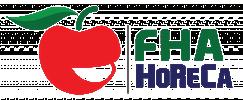








The Food and Grocery Council is an industry association for grocery suppliers providing members networking, events, industry information and strong advocacy. Contact us for information on the benefits of membership: raewyn.bleakley@fgc.org.nz
Networking
Industry Updates
and Events
and Training


Fonterra Co-operative Group Ltd has announced changes to its Management Team to support the next phase of its strategic delivery.

APalmerston North sheep farmer has been disqualified indefinitely from being in charge of animals and fined $13,000

Woolworths has helped fundraise for our local food rescue partner Kairos by offering a 60 second ‘trolley dash’ as an auction prize

The ongoing need to fund Hauraki's 1,000-square-metre Social Supermarket





Tui encourages feedback following the relaunch of its iconic campaign.
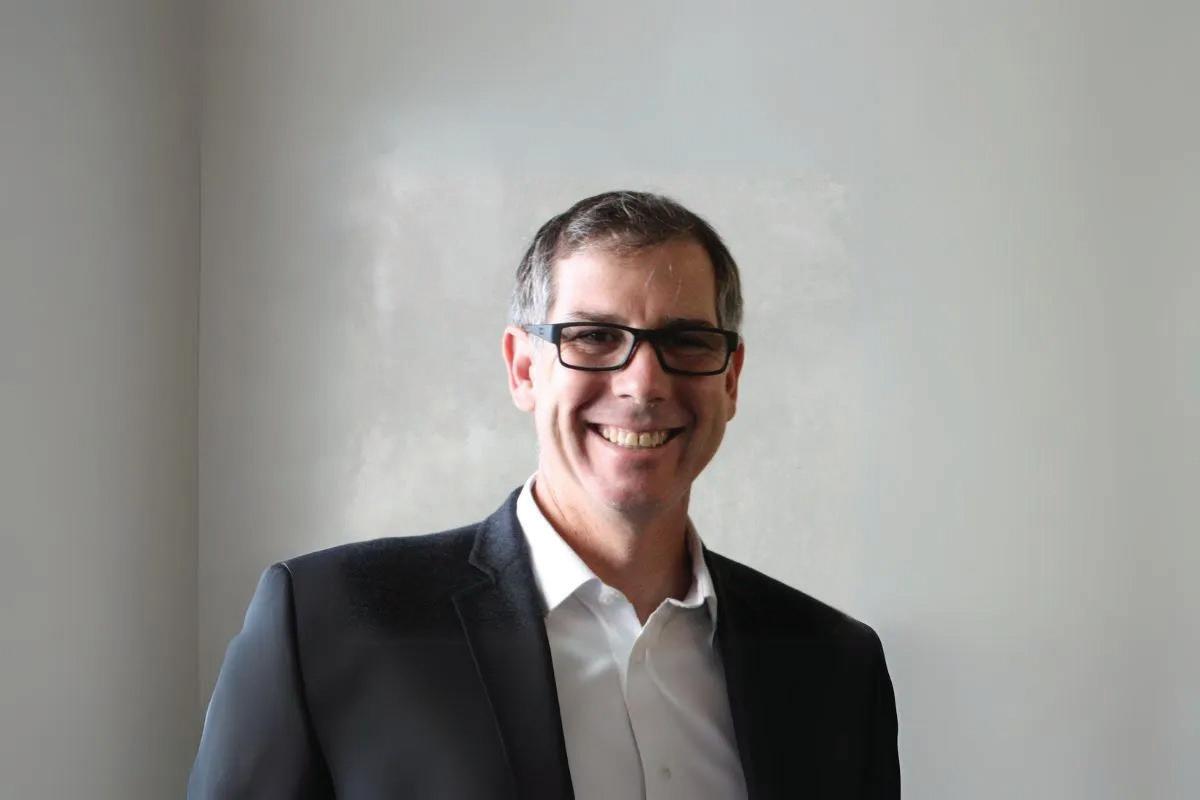
A horticultural heavyweight and one of New Zealand’s longest-established businesses, Jenkins Group Ltd announced a new MD.

Sinclair and Zespri join forces to revolutionise sustainable labelling.

Japan’s number one beer, Asahi Super Dry, has continued its successful partnership with the Rugby World Cup.






Krispy Kreme has introduced its Ghostbusters Collection, commemorating 40 years of the iconic film in time for Halloween.

Close to 2,000 gathered in the Hawkes Bay sunshine to celebrate New Zealand icon Wattie’s turning 90.

New World Mount Albert is officially open for business again, 18 months since it closed due to flood damage.

Businesses are changing the way they operate, with more AI and a shift in hybrid working –Hunter Campbell Mood of the CFO Survey.


Greenpeace Aotearoa has sued Fonterra for misleading customers.
As more Kiwis explore ways to prepare and eat whole fish, Foodstuffs North Island has made fresh whole fish more accessible in its supermarkets.







Cookie Time
Something cool is coming from Cookie Time, set to make new waves in the ice cream category. The iconic brand is launching 470ml ice cream tubs, available nationwide from 28 October. In two flavours – Cookie Chunk Caramel and Triple Chocolate Brownie Dough – the tubs follow on from last year’s Cookie Time ice cream sandwich launch. 0800 COOKIE TIME.

Farrah's
Farrah’s, leader in the wraps category, is thrilled to launch its new Ultra Keto Wraps – setting a new standard with the lowest carb option on the market.
The launch follows the success of Farrah’s initial Low Carb Keto Wraps, which quickly claimed the #1 Wrap ranking in NZ grocery and continue to drive 19.4% of total category growth (Circana data to 29/09/2024). Without compromising on taste or texture, Farrah’s has once again raised the bar for low carb and ketoinnovation.
Farrah’s NEW Ultra Keto Wraps have only 1.4g of carbs per wrap – 92% less carbs than Farrah’s White Snack Wrap. They’re also an excellent source of fibre, contributing to 44% of the recommended daily intake.
“Our Ultra Keto Wraps offer even more variety for those following a keto or low carb lifestyle, and the ultra-low carb level means consumers can enjoy more in each meal,” says Jasmine Currie, Farrah’s Head of Marketing.
Like all Farrah's products, these Ultra Keto Wraps are also vegan-friendly, yeast and dairy free, and proudly flame baked in Upper Hutt.
After a successful launch into Foodstuffs in August, Farrah’s Ultra Keto Wraps are also now available in Woolworths stores nationwide.
For more information on Farrah’s Ultra Keto Wraps and some delicious recipe inspiration, visit www.farrahs.co.nz.

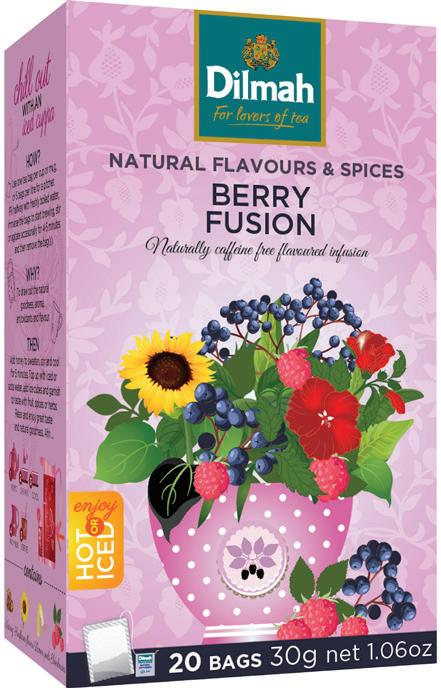

Dilmah
There are some occasions that have consumers reaching for Green Tea or Fruit & Herb Infusions to provide solutions for their consumption moment. Whether it’s to meet needs such as ‘to help me sleep’, or to ‘aid digestion’ or to ‘de-stress’, consumers are looking for functional goodness without compromising on taste.
Dilmah is the largest Green Tea brand in NZ, with the fastest value growth +15% vs YA. Dilmah continues to innovate with flavours to ensure ‘Goodness really does Taste Great’!
Green tea is well known for its wonderful digestive aiding properties and calming effects. That is why
Dilmah Green Tea has combined the flavour profile from their No.1 infusion SKU to bring you Dilmah Green Tea with Cinnamon & Turmeric. A beautiful flavour profile that combines the antioxidant goodness of green tea with the anti-inflammatory properties of Cinnamon & Turmeric.
Dilmah’s Fruit & Herb Infusions (Dilmah Cinnamon, Turmeric Ginger & Nutmeg 20s and Dilmah Ginger and Peppermint 20s) are in double digit growth, outpacing the Tea Category. Consumers will be pleased to know there are another two SKUs being added to the family, both caffeine free and providing a perfect
afternoon or evening beverage for that ‘wind down’ moment.
The new Dilmah Berry Fusion has a lovely complex, fruity taste balanced with a touch of cinnamon, while Dilmah Lemon & Ginger has a prominent lemon character embraced by the characteristic 'warmth' of Ginger.
On top of this, Kiwis have once again voted Dilmah as the ‘Most Trusted Tea Brand’ so you can ‘Do Try It’ with confidence.
*Source: Circana - NZ Grocery, Value Sales MAT to 06/10/2024
*Readers Digest Most Trusted Brand survey 2024
Barker's
Barker’s of Geraldine have extended their beverage portfolio to include a range of Cold Brew Coffee and Fruit Tea Syrups.
The Cold Brew Coffee syrups are made using real, ground L’affare coffee beans and come in two flavours – Original Cold Brew and Caramel Cold Brew. These rich and smooth coffee syrup blends make it easy to create the perfect iced coffee, affogato or espresso martini. Just pour the coffee syrup over ice and add your choice of milk for a delicious and easy iced coffee at home.
Barker’s have also crafted two tasty Fruit Tea Syrups – a classic Peach, and a nostalgic Feijoa & Lime pairing. These




Fruit Tea Syrups combine a tea infusion with refreshing fruit and botanicals and can be mixed with hot, cold or soda water. They’re perfect for iced teas, hot brews and sparkling spritzers. No brewing required.
With tea and coffee beverages continuing to grow in popularity,
these new syrups provide alternative offerings that are both versatile and sustainable, with no artificial colours, flavours or preservatives – and so many opportunities to get creative!
To find out more visit www.barkers.co.nz






Tilda
Made with specially selected grains, Tilda sticky rice has a delicious, subtle taste and a perfectly sticky texture, making it ideal for Poke Bowls and Sushi. It's ready in 90 seconds only.
Raglan Food Co
Raglan-based coconut yoghurt makers
Raglan Food Co are celebrating 10 years in business, a significant milestone for the Waikato producers. To mark the occasion, the company has launched three enticing new products which hit shelves this month.
The new line-up includes a limitededition New Zealand Mānuka Honey yoghurt in 700g, a larger size of their popular Dulce De Leche Caramel yoghurt in 400g and finally, a Vanilla Bean Gut Health Kefir packed with billions of probiotics.
Head of marketing Sarah Phillipps said the new range has already received much positive feedback from customers.
“Our limited-edition strategy
Cheez-It
Making its antipodean debut, Cheez-It Snap'd, made with real cheese and in two flavours, is now available at Woolworths.
The American snack sensation, Cheez-It, has made its grand debut on New Zealand soil. Prepare your taste buds, as the new Cheez-It Snap'd, packing a cheesy punch, made with real cheese, is now available exclusively at Woolworths, delivering tantalising satisfaction bite after bite.



is working really well for us and we’ve been able to add unique and appealing flavours to our range which are resonating with existing and new customers alike,” said Phillipps.
“Our Dulce De Leche Caramel has been a runaway hit, and we are stoked this product was also a finalist in this year’s New Zealand Food Awards (powered by Massey University).”
Customers can look out for some bespoke 10th birthday labels on Raglan Food Co’s 700g range over the summer period, too. A proceed from the sales of Raglan’s 700g coconut yoghurt during November 2024 will also be donated to two charities close to the company’s heart.
“As part of our 10th birthday


celebrations, we’re making a special birthday donation to Auckland City Mission and our local Whāingaroa Environmental Centre as part of our commitment to community and sustainability and as a way to pay forward the support we’ve received over the last decade.”
Raglan Food Co was founded by Tesh Hearth (nee Randall) and Seb Walters, pioneering both plant-based and dairyfree yoghurt in New Zealand. The goal of making uncompromisingly tasty products that “lift the vibe on plantbased eating” has remained an integral part of the company’s fabric.
To learn more about the 10-year journey and range, visit: www.raglanfoodco.com

Harraways
Market leading, New Zealand oat miller Harraways, is presenting its quality rolled oats range in a fresh new stand-up pack.
Beginning to hit New Zealand grocery shelves from early October, New Zealand’s favourite Rolled Oats will stay fresher for longer AND they can be recycled into new, useful items like fenceposts for kiwi farms. Keep an eye out for the fresh new look, hitting shelves soon!
For more detail, please head to: https://harraways.co.nz/pages/ recyclable-harraways-oats-bags.

Picky
Picky is a new beverage brand that has perfected delicious, freshly squeezed juices and smoothies.
Made in Hawke’s Bay and launching this month across New Zealand, Picky is a new beverage brand that has perfected delicious, freshly squeezed juices and smoothies.
From the team behind Boring Oat Milk, Picky is the new name, look, and feel for Boring’s previous sister brand, The Apple Press. It offers six juices and four smoothies crafted from the highest-quality ingredients without concentrate.

Pic's Peanut Butter
For favourite kiwi brand Pic’s Peanut Butter, supporting what’s important to New Zealand and Te Reo Māori has been an important part of its national identity.
Pic’s want to build healthier communities with good food, supporting the Māori view of manaakitanga. The brand has brought back its Te Reo Māori label edition, available exclusively at the Nelson store and online.
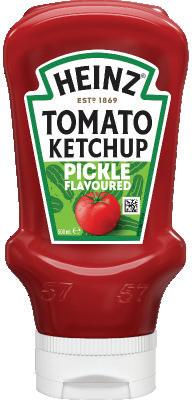
Heinz
Coming to Kiwi shores is a new condiment flavour – Pickle Flavoured Ketchup.
After causing a stir overseas, Heinz Pickle Flavoured Ketchup is now available in New Zealand.
Brace yourselves because Heinz is about to flip your burgers and fries upside down with a mouth-watering, taste-bud-tickling new creation.





With people being short of time and leading busy lifestyles, the options for easy meal solutions have become increasingly popular, such as ready-made meals, food to go and easy, convenient recipes.
Catering to this consumer need, Riley White and Mackenzie Brownlee, owners of the new On the Spot in Northlake Wanaka, introduced an ever-changing ‘grab and go’ range, frozen meals, and an abundance of quick and easy meal ideas.
“We often post quick dinner options using ingredients found in-store on our social media. Our vision for the store is to be the hub of the community. It’s a very nostalgic feeling to have kids pop down to get the milk and bread and grab a lolly or two,” said Brownlee.
“We are constantly adding to our grocery range and customers' requests and adapting our food-to-go range. We have some exciting plans for the future of our store, but for now, we’re keeping these under wraps.”
From the store's concept stage, White and Brownlee recognised the importance
of offering sustainability and plant-based options for customers. They considered themselves lucky enough to live and work in a region big on looking after the environment and educating the community on ways to ‘live off the land’.
They needed to ensure the store had a wide range of products that would suit the community, from recyclable and compostable packaging to plant-based meal options.
“We are constantly growing our range and envisage more plant-based products. We like to think that we have created a safe and happy place for our customers to visit –from a ‘gidday’ as they walk in the door to helping them take their groceries to the car.”
Having worked hard to grow it into a cohesive space with a ‘bit of everything and a little more’, they have been fortunate to be in a supportive community where they know many customers by name and usually


their coffee or food-to-go orders.
Brownlee said their customers are always delighted when coming in for the first time, as they perceive that they will have the usual suspects like bread and milk, but it is much more than a typical ‘corner store’.
Since opening, the store has added over 500 products. Customers have also requested various items be stocked, and mere days later, they have found them on the shelf.
“Getting the store running has been an outstanding achievement for us both. When the opportunity came up to open a store in our neighbourhood, it was a dream we never thought possible. It was not an easy feat. We witnessed the building from the ground up, and it was a long process with some stressful moments thrown into the mix. It was a fantastic learning experience; we’re very proud of the result.”
On the Spot, Northlake Wanaka has also supported local communities. European
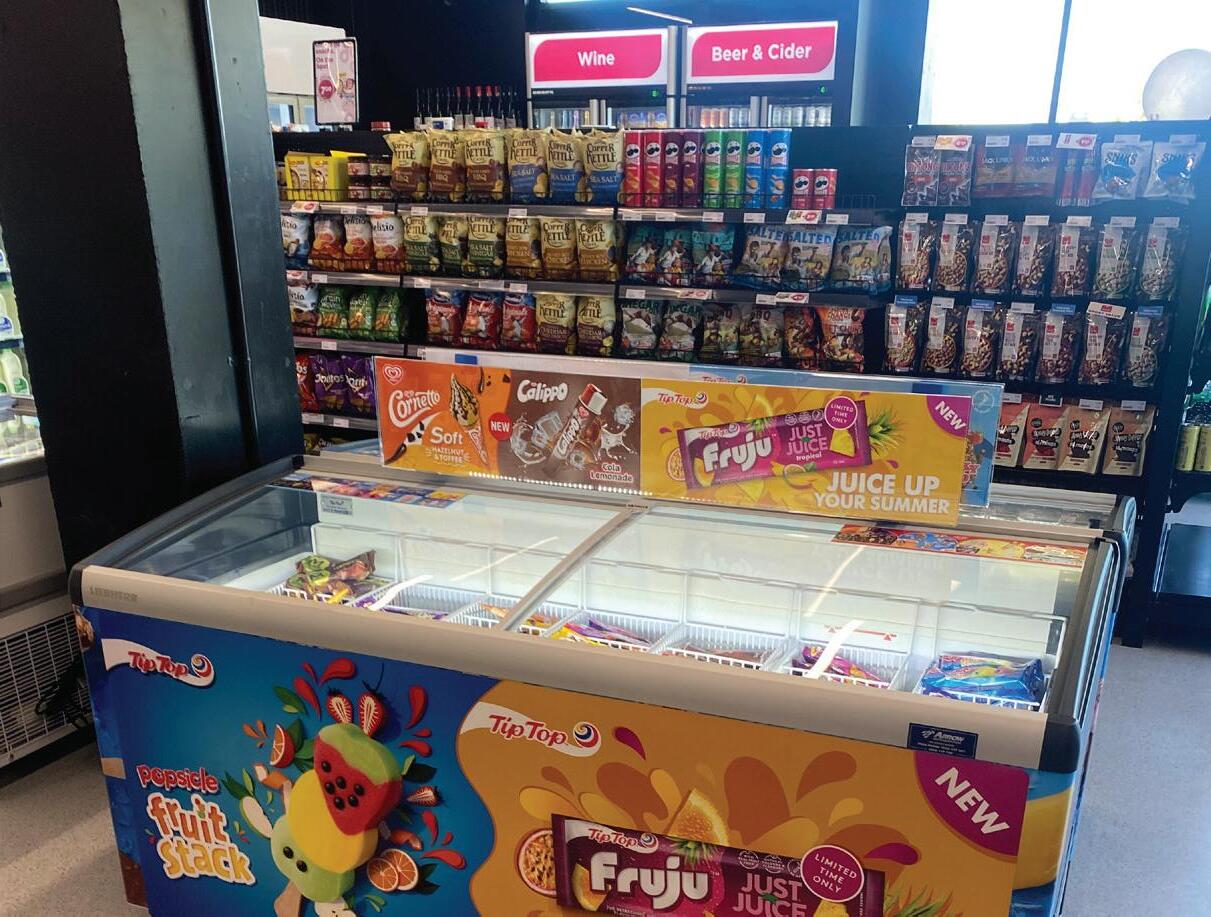
Bakery from Queenstown was very exciting to have on board. It was delivered fresh and has been incredibly popular. Another nonnegotiable was the infamous Sanga’s Pies, which have been much loved by customers.
“If you haven’t tried one, you must. We love to support Pinnacles Daycare, from hot cross buns at Easter to boxes of bananas for baking. It’s close-knit here in Northlake, and we wouldn’t have it any other way.”
On the Spot, Northlake Wanaka will also host a fundraiser for the local charity Food For Love and has planned to support other local initiatives and groups further.
Brownlee also highlighted the growing trend of online shopping as a significant opportunity within the grocery industry. She said grocery stores can expand their reach by offering seamless online ordering, delivery, and pickup options combined with personalised shopping experiences that offer recommendations and promotions based on
customer preferences and purchase history.
“Sustainability and waste reduction are essential; we plan carefully to minimise our waste. Riley does our product ordering and does a perfect job forecasting quantities so we use what we get.”
She believed that On the Spot Northlake Wanaka can contribute to a more sustainable future for the grocery industry, reducing its environmental impact and meeting the ever-expanding expectations of the more environmentally conscious consumers.
“Our store is relaxed and inviting, creating a great shopping experience. We have a great team culture where fun and comfort are paramount, and customer service is our number one priority,” she added.
“As owner-operators, we are extremely hands-on, and you can find us in-store daily. As the cliché goes, ‘teamwork makes the dream work,’ and our team is no exception.” n




Earlier this year, insights from The Food Industry Association (FMI), Oliver Wyman, and Circana demonstrated new opportunities for food industry trading partners to cater to shoppers’ expanding definitions of value.
The research showcased how food and beverages that promote wellbeing and competitively priced products that were decidedly convenient to buy and prepare could ultimately earn shoppers’ allegiance.
“We are witnessing shifts toward foodservice spending, a rise in digitisation, and return-to-office protocols that all provide food and beverage retail opportunities to improve how they deliver on what matters most to consumers,” said Mark Baum, senior vice president of industry relations and chief collaboration officer, FMI.
While 87 percent of the morning and 76 percent of midday eating occasions had been sourced from home, there was an increasing trend toward food service across many consumer segments, mainly Gen Z and Gen X, reflecting growing demand for convenience.
“Time is of the essence for Americans, especially regarding their morning routines,” said Sally Lyons Wyatt, global EVP and chief advisor, consumer goods and foodservice insights, Circana.
“Sixty-five percent of morning eating occasions are prepared in less than five minutes, and we see opportunities for new appliances that give consumers quick solutions, with the microwave gaining the most ground since 2020.”
In the evening, lower-prep, quick-cleanup, and fewer ingredients were growing trends.
“Dinner represents the largest financial upside for retailers winning at home relative to other eating occasions throughout the day,” said Oliver Wyman Partner Randall Sargent.
“To increase their share of evening consumption, retailers and suppliers must offer sufficiently convenient solutions and the varieties of cuisines and textures found in a food service offering.”
FMI Vice President of Research and Insights Steve Markenson also emphasised how retailers could share a compelling story about how these solutions meet busy consumers' value-for-money and health preferences when preparing their midday food and beverages.
“The insights demonstrate how our industry can be successful by capitalising on consumers’ shifting habits, especially when

companies consider dayparts, such as snacks, to inspire experimentation and create new memories through food,” said Markenson.
The analysis pointed to opportunities to explore new channels by competing for untapped potential in places primarily occupied by food distributors as another way to consider how the food industry can cater to newfound eating experiences among consumers.
Recently, Circana released insights from its Future of Dinner report, revealing that U.S. consumers sourced 81 percent of their dinners at home and most often enjoyed dinner with others.
While Gen X preferred dinners that required minimal preparation and few ingredients, Gen Z consumers increasingly invested in special occasion dinners as they honed their kitchen skills and sought noprep dinner solutions.
Gen Z consumers have just started to learn their way around a kitchen and will want to advance their cooking skills while balancing quick dinner meals. They are also more likely to indulge in their favourite dishes at dinner or have a treat or reward for dinner. Their key projected categories through 2026 include centre-of-plate proteins, breakfast foods, and ready-to-eat snacks.
Older Gen Z consumers would lean on recipes and participate in invested dinner occasions as they begin living independently. They were the most likely to choose an item at dinner strictly because they did not want to cook.
Gen X consumers will continue choosing dinners that satisfy their cravings, tastes, and favourite dishes. Gen X will also make dinners with items on hand more often than younger generations.
Combination dishes, such as rice bowls, are expected to grow over the next two years, driven by Gen X consumers who won’t increase their use of traditional centreof-plate proteins at dinner. Instead, they will opt for more diverse meal options that blend flavours and ingredients.
“More than one-third of dinners are motivated by a need for connectedness, and how consumers meet this need depends on various factors,” said Darren Seifer, industry advisor, Consumer Goods and Foodservice, Circana.
“With the shifting demographics of our population, such as Gen Z entering adulthood, we can expect corresponding shifts in dinner foods and preparation methods. It’s crucial to look at these varying consumer behaviours to meet their growing needs.” n

Time to defrost Mariah & dust off the Christmas tree
Clean the BBQ + GET GAS BOTTLE
Buy the new Rum & Que Sausages & Smashed Burgers for Xmas BBQ
Get that Meditation app to help with the in-laws
Get some chicken for the kid’s lunches
Panic-buy Christmas gifts
Thank Heavens for Hellers
A recent consumer poll found that chicken remains a staple in New Zealand households, with 91 percent of respondents reporting they purchase it regularly. The survey represented all age groups and closely matched New Zealand's demographic spread.
Chicken remains a popular protein choice, but many shoppers, additionally, nearly one-third of chicken buyers (29 percent) regularly include plant-based meals in their diet.
More than half of respondents said they prefer chicken over beef and lamb most of the time, with nine percent choosing it exclusively.
Younger consumers, especially those aged 25-34, were particularly loyal to chicken, with 71 percent saying it's their go-to protein. In contrast, those aged 45-64 showed more flexibility, often varying their protein choices.
Affordability and popularity as a family favourite were key reasons behind chicken's appeal. Ease of preparation, versatility, and high protein content also contributed to its popularity. For those older consumers, affordability and convenience were equally important; similarly, older consumers (65+) prioritised convenience (84 percent) and affordability (76 percent).
Chicken breast was the most popular cut, regularly purchased by over three-quarters of participants. Drumsticks, thighs, and nuggets followed closely. Interestingly, nuggets were particularly favoured by the 18-24 age group, while older consumers aged 55-64 preferred drumsticks. Whole chickens continue to be popular, especially among those over 65, who enjoyed them

for a quick and easy dinner.
Rotisserie chicken remains a hit, with 85 percent of respondents purchasing it at least occasionally, although only seven percent do so weekly. Monthly buyers were most common among people aged 25-34 and 65+.
Regarding production standards, hormone-free chicken was most valued, followed by antibiotic-free and cage-free options.
Dinner remains the primary occasion for eating chicken, but sliced chicken and nuggets are just as popular for lunch. Notably, the 18-24 age group reported eating nuggets more often at lunchtime than for dinner. For more information about Focus Insights click here. n


HOW OFTEN DO YOU CHOOSE CHICKEN OVER OTHER PROTEINS LIKE BEEF AND LAMB DUE TO PRICE?

WHAT ARE THE MAIN REASONS WHY YOU CONSUME CHICKEN?




With a shared love for food, design and messing with their grandmothers, Grga Calic and Lachlan Philp have reinvented an Italian staple.
Based in Australia, Calic is an advertising creative in Sydney, and Philp is a graphic designer in Melbourne. Calic said that Sorry Nonna had started as a joke.
“I had an idea for a video of nonnas tasting a pasta sauce and absolutely hating it because it’s not like theirs. I joked about it with Lach, and we realised you could make that into a brand. Then Sorry Nonna was born,” said Calic.
“We love our nonna, and we love pasta, but both have become boring. So we stole
nonna’s recipe and spiced it up.”
The first product launched by the startup was a small batch of Aussie-made pasta sauce with a twist of spice. The Gochujang Arrabbiata, aka Spicy Lil’ Nonna, has been the duo’s take on a classic Arrabbiata sauce.
“Just like Nonna, it’s the perfect mix of sweet and spicy—but with a twist: a hit of Gochujang for added heat and umami flavour.”
READ ONLINE HERE
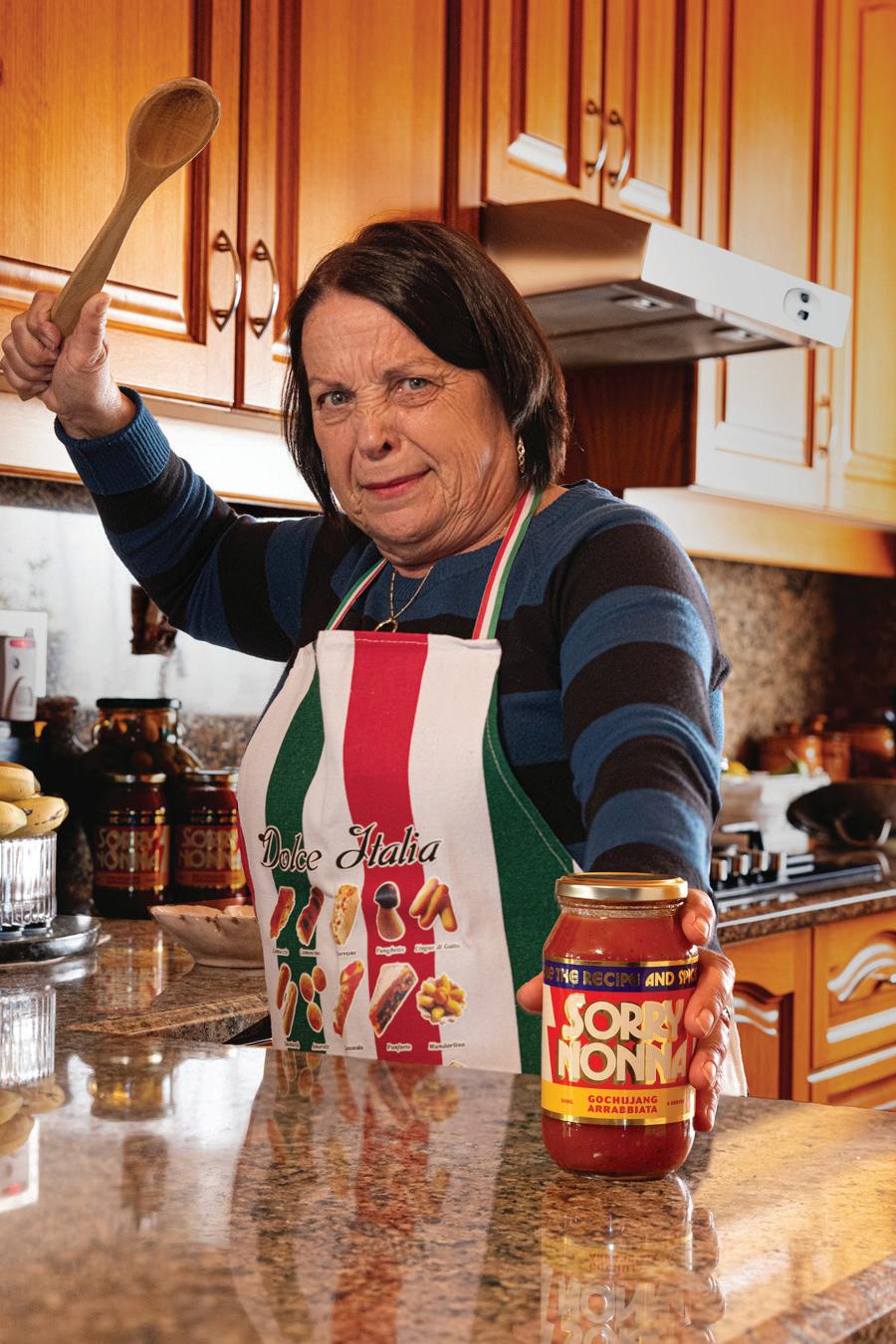


Inspired by a hunger for the great outdoors and great food, the Beard Brothers’ mission has been to craft the finest handcrafted barbecue delights from pure New Zealand ingredients and bring families together around the grill.
Using heritage recipes and traditional techniques, the Beard Brothers range includes sausages, patties, and sausage rolls, bursting with flavour, perfect for your next barbecue feast.
The meat for these has been sourced from a trusted network of suppliers committed to sourcing from sustainable Kiwi farmers, ensuring it’s grass-fed, free-farmed, and absolutely delicious. The natural sausage casings make all the difference, providing a texture and taste reminiscent of childhood
backyard barbecues.
Beard Brothers have proudly embraced an authentic and honest approach, carefully selecting natural ingredients and processes that elevate their sausages. This extensive range has also catered to various dietary considerations. Most of the Beard Brothers range is gluten-free and contains no added MSG.
Sausages and patties are essential staples at Kiwi BBQs. They bring flavour and heartiness to any gathering, and their sizzling aroma entices everyone to the grill.
Crafted with grass-fed, free-farmed New Zealand lamb and using Mrs Rogers' carefully selected and certified organic Moroccan seasoning blend, Beard Brothers Moroccan Lamb sausages are the perfect addition to any meal year-round.
Part of the Pitmaster Series, the Venison Ram Rod Sausages have been made in collaboration with Rum and Que for their Pitmaster mastery. This collaboration has brought an extraordinary range of craft sausages to your BBQs and kitchen tables, using free-range 100 percent New Zealand
venison with the least amount of processing possible in natural casings for the best flavour.
An old-school beef pattie has always been a BBQ’s best friend. Made from pure grass-fed beef, these patties are coarsely ground with a few essential herbs and spices to complement the stand-alone pure beef flavours. Beard Brothers beef patties are perfect for those impromptu get-togethers with many mouths to feed.
No Kiwi BBQ is complete without the crowd-pleasing sausage rolls. The Beard Brothers' Beef Sausage Rolls, reminiscent of their Original Beef Sausages sans the natural casing, are wrapped in a golden, flaky pastry.
Like its beef counterpart, Pork Sausage rolls are minimally processed and cook quickly and easily, making them a tasty and convenient snack or meal addition to serve at the table.
With its commitment to authenticity and quality, Beard Brothers caters to various consumer flavour preferences and trends. Whether hosting a backyard barbecue this summer or enjoying a family dinner at home, Beard Brothers' handcrafted products elevate any meal. n


Born in a small West Coast pub, Glasseye Creek Sauces has evolved into a standout player in New Zealand’s crowded sauce market, known for its dedication to crafting sauces with the finest natural ingredients, slow-brewed for over nine hours to create rich, smoky flavours and capture the pure, natural and wildly unique culture of the West Coast.

The story of Glasseye Creek began in 2008, when founder ‘Don Keebles’, facing personal struggles and the global financial crisis, moved to the remote communities of Little Wanganui and Karamea to seek some sanity.
He was invited by his close friend, Dave White, the local pub owner. White’s pub menu, filled with wild pork and venison, inspired Keebles to create a sauce that would embody the bold flavours of the West Coast. Driven by his passion for both food and community, Keebles spent six months perfecting a unique, flavoursome sauce in his small kitchen.



The locals quickly embraced Glasseye Creek Sauce, and it became a staple at White's pub, used in a variety of dishes from marinades to casseroles. After White’s sudden passing in 2009, Keebles decided to transform Glasseye Creek into a business, launching the brand across New Zealand.
Reflecting the rugged natural environment, Glasseye Creek sauces are made with real, locally sourced ingredients whenever possible, such as freshly squeezed orange juice from Hawke’s Bay, Canterbury blackcurrants, and Marlborough wine vinegars. The brand also incorporates high-quality international ingredients like Californian raisins, three day smoked jalapeños from Mexico and Kikkoman Soy Sauce from Japan to enhance its bold flavours.
The range now includes the original Wild Meat Sauce, described as rich, smoky, and gutsy, and the Pretty Hot Meat Sauce, with its balance of smoked jalapeños, woodroasted NZ tomatoes and Canterbury blackcurrant. The Forking Mint Sauce is a premium salsa verde style sauce made with extra virgin olive oil, capers and Dijon mustard from France.
Keebles insisted that high-quality, natural ingredients resulted in superior sauces that not only taste better and are healthier, but also cook better in BBQs, pizza ovens, smokers and in the home oven, as there are no artificial sugars that burn, avoiding the bitterness common in sugar-laden
alternatives. Looking ahead, Keebles hinted at exciting new projects, including exploring boutique flavours set to capture upcoming food trends whilst embracing their culture and brand born in the rugged and raw West Coast of the South Island.
At its core, Glasseye Creek has retained its authentic, community-focused ethos, embodying the Kiwi spirit and remaining connected to its origins. This commitment to authenticity and quality continues to set Glasseye Creek apart in a competitive market. n
minutes with





The makers of the JENNIE-O turkey brand, a trusted brand for turkey products worldwide, announced their 2024 Thanksgiving survey results. Talker Research surveyed 5,000 consumers across the U.S. on their preparation methods, turkey preferences, preferred sides, and more.

Thanksgiving has been a beloved holiday, and 70 percent of Americans said they had celebrated the traditions for over 20 years. The three most cherished traditions were sharing meals (65 percent), spending time with extended family or old friends (52 percent) and cooking together (27 percent).
Most people took up to two weeks to plan and cook their Thanksgiving meal. Preparing food for this eating occasion took another three days and five hours on Thanksgiving. The longest prep time was spent in Delaware, Virginia, and North Carolina.
Delaware averaged 17 days of guest-list planning and another 19 days of menu building. Virginia spent almost 16 days
picking guests and nearly 17 days on the menu, while North Carolina averaged more than 17 days on the menu alone.
The star of the Thanksgiving table has traditionally been the turkey, with 66 percent of respondents preferring to bake their turkey and 63 percent saying no to brining it. Oklahomans chose to smoke their turkey more than any other state.
While most Americans prepare their turkey the same way yearly, keeping with their traditions, more than 30 percent of Americans change it up every holiday season.
In addition to turkey, nearly 40 percent of Americans also liked to have ham on the table, with preferences for baked (68 percent), smoked (18 percent) and slowcooked (18 percent) ham.
Although 61 percent of Americans believed that turkey is the star of the meal, a little more than two in five respondents in Idaho and Kansas believed that the side dishes were the unsung heroes.
The most popular sides were stuffing (77 percent), rolls/biscuits (66 percent), classic mashed potatoes (60 percent), and cranberry sauce (55 percent). Americans from the Southeast also enjoyed mac and cheese.
Almost every American surveyed (96 percent) enjoyed Thanksgiving leftovers, as 44 percent used turkey in a sandwich, 41 percent incorporated turkey into other meals, and 32 percent even recreated the actual Thanksgiving meal.
More than one in five would rather keep their leftovers for themselves than send some home with their guests.
“Thanksgiving continues to be one of America’s most cherished holidays, bringing families and friends together to share meaningful moments and meals,” said Kim Anderson, senior brand manager for the JENNIE-O brand.
“We’re committed to helping ensure your holiday meal is a success with our quality turkeys and our wide range of services and resources.”
Consumer engagement experts for the JENNIE-O brand will be on hand to help alleviate stress around holiday meal planning. n



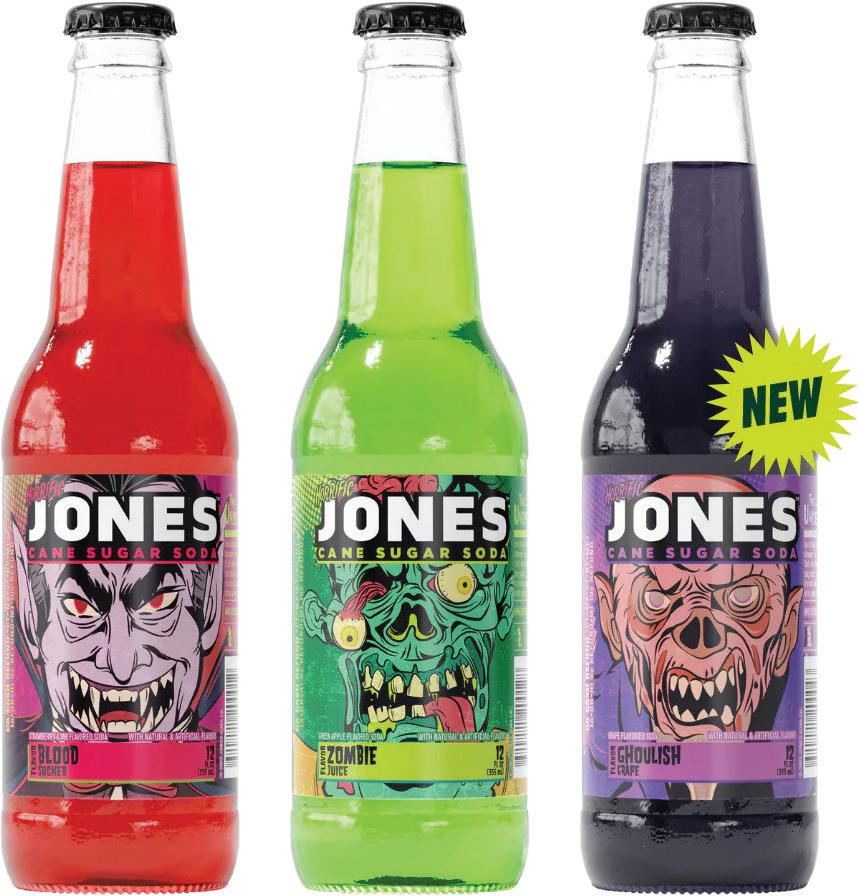



scarily good monster munch pickled flavour mayo by Heinz








As temperatures drop and the cosy season is in full swing, Sainsbury’s, Argos, Habitat and Tu experts have revealed their predictions for the autumn months and upcoming festivities.
Txploring search and sales data alongside consumer research, Sainsbury’s Seasonal Spotlight report uncovered what the UK has been eating, drinking, wearing, and gifting and how it is decorating this festive season.
The retailer has identified five key themes for this autumnwinter season:
Autumn and Pre-Christmas Searches for ‘autumn decor’ on Argos soared by +2,274 percent in the first two weeks of September 2024 vs 2023. Meanwhile, demand for autumn-themed pyjamas skyrocketed as Halloween became more popular.
Thanksgiving feasts and ‘Friendsgiving’ getaways in the UK were also on the rise, as 34 percent of people intended to host the traditionally American celebration for the first time.
Looking ahead to Christmas, decorating the home for the main event has been brought forward with Sainsbury’s customers purchasing Christmas decorations as early
as September. Sixteen percent of Brits have planned to purchase all their festive party wear by the last week of October.
Retro revival has returned as bold and oversized Christmas decorations reign supreme. Searches for multi-coloured Christmas lights also increased by +1,003 percent yearly as almost a quarter of Brits said they would opt for colour this December. Red wine hues have also become popular in interiors and fashion choices.
Brits have prioritised convenience in the kitchen in exchange for more time with loved ones. Last December, an air fryer was sold every 8.3 seconds at Argos to speed up Christmas cooking, and this year, 22 percent of hosts expected guests to bring ready-made dishes, sharing the love and the load.
Grilling has also been set to be popular, with 17 percent planning to host a barbeque party during the festive period. Sainsbury's reported a +74 percent increase in December burger sales over the past two years.
Millennials will also take on more festive

duties in 2024, as over a third (39 percent) will host Christmas for the first time this year.
Throwback dishes such as trifle and prawn cocktails, nostalgic décor and gifts have proven popular for 2024, as many took a trip down memory lane to integrate old traditions with the new.
Three in five millennials bought food that sparked childhood memories, and 45 percent want to adorn their homes with nostalgic decorations. Nearly half (47 percent) have already watched a Christmas film and looked to recreate memories for the most beautiful time of the year.

Gifting Galore
‘Kidult-ing’ is the new trend for Christmas, with old-school toys, including Furby and Beyblades, set to make a comeback. As a result, 34 percent of Brits have planned to buy younger relatives the toys they enjoyed as children.
Searches of retro items were also on the rise, showing the nation is set to gift the golden oldies with record players (+22 percent) and flip phones (+21 percent) increasing significantly. Pets have also been getting in on the festive fun, with 38 percent of Brits planning to buy a gift for their furry friend this Christmas, which increased to 44 percent for Glaswegians.
“It’s the most wonderful time of
the year. We know our customers are seeking solutions that take the fuss out of preparation and hosting for the festive season, so we're all about “Christmas-madeeasy"; think ready-to-drink cocktails, air fryer-friendly party food and convenient, quick-cook centrepieces – all just as big on wow factor as they are on flavour,” said Claire Hughes, Director of Product and Innovation at Sainsbury’s.
“Panettone is synonymous with Christmas, and this year, we’ve taken it to the next level with a chocolate and hazelnut and a limoncello variant that are perfect for gifting. We’ve even got a mini panettone in a tin that’s just the right size for a stocking. From tipples like our dessert-
inspired liqueurs to an eye-catching light-up terrarium, there’s something for everyone.”
She added that Christmas was also a time for nostalgia, and this year, 60 percent of the nation planned on rediscovering the joy of retro dishes that harked back to the trends and traditions they grew up with.
"We know our customers want to make the most of the festive season, and our research shows that 44 percent of UK adults enjoy the celebrations even more now than when they were younger,” said Matt Leeser, Commercial Director, Argos, Habitat, and Tu.
“Our customers have already started to embrace their Christmas shopping, with visits to our Christmas page already up by +121 percent compared to last year.” n




The race to harvest New Zealand's fastest-growing vegetable will hit full speed this month, with over one million spears of asparagus being hand-cut daily.

Boyds Asparagus Industries Ltd, based in Cambridge, is a member of the NZ Asparagus Council and produces one third of our national crop. Managing Director Andrew Keaney says freshness is the key to winning over consumers and driving retail sales.
“We pick, pack and dispatch on the same day to ensure peak freshness. We also use precooled, washed and hydro-cooled processing to maintain optimal quality. The most important thing that retailers can do is keep the product fresh by only buying what they can sell in a day,” he says.
“The flavour and texture of asparagus is so different when it’s fresh compared to when it’s three or four days old.”
With over 130 hectares of production, Boyds is a leading grower, packer and marketer of asparagus. The business was established in 1982 and the Waikato’s fertile, well-drained soils are ideal for asparagus cultivation.
“It’s very fast growing. On a warm, hot day it’ll grow up to 17cm. You can literally lie in a field and see it moving. To try and understand how much I’m going to pick the following day, I put a peg in the ground each morning so I can measure the speed at which it’s growing. It all depends on the temperature.”
Thanks to favourable weather conditions, the season started in early September –about 10 days earlier than normal. Supply
will run through until Christmas.
“I love eating asparagus. It’s nutritious, packed with goodness, and incredibly versatile and convenient to cook. Growing asparagus allows me to combine my passion for high-quality food with my love for working in the fields.”
Keaney says the biggest industry challenge is driven primarily by cost inflation.
“We’ve focused on increasing efficiency by incorporating technology and automation where possible. However, the cost of harvesting remains our most significant hurdle. Each asparagus spear is still harvested by hand, as no automation technology exists to handle this task efficiently.”
While robots are currently used in limited prototypes in the UK, they are still far from commercialisation. Even when this milestone is reached, Keaney says robots will not provide a complete solution and human labour will remain necessary.
“Asparagus doesn’t grow in a straight line. The crown beneath the ground shoots up asparagus spears in different directions. A robot has to position itself over each crown and assess what spears are ready to pick, then constantly reposition itself. There might be one spear that’s not quite ready. You have to be able to see what the best angle is to cut each spear without damaging the one growing beside it which is too hard for a robot to do.”
Boyds will employ around 200 people this month to ensure the crop is harvested in time. “During peak season, we pick over one million spears daily, with our harvest crews covering more than 1,000 kilometres of fields each day. Given asparagus’s rapid growth, it’s crucial to harvest daily to prevent the spears from becoming too mature and going to seed.”
Once in store, Keaney says asparagus should ideally be kept refrigerated. “But ambient temperature is okay as long at the product is fresh that day.”
Spears should be firm to touch (not limp) and the butt (where it has been cut) shouldn’t be dry or caving in. n

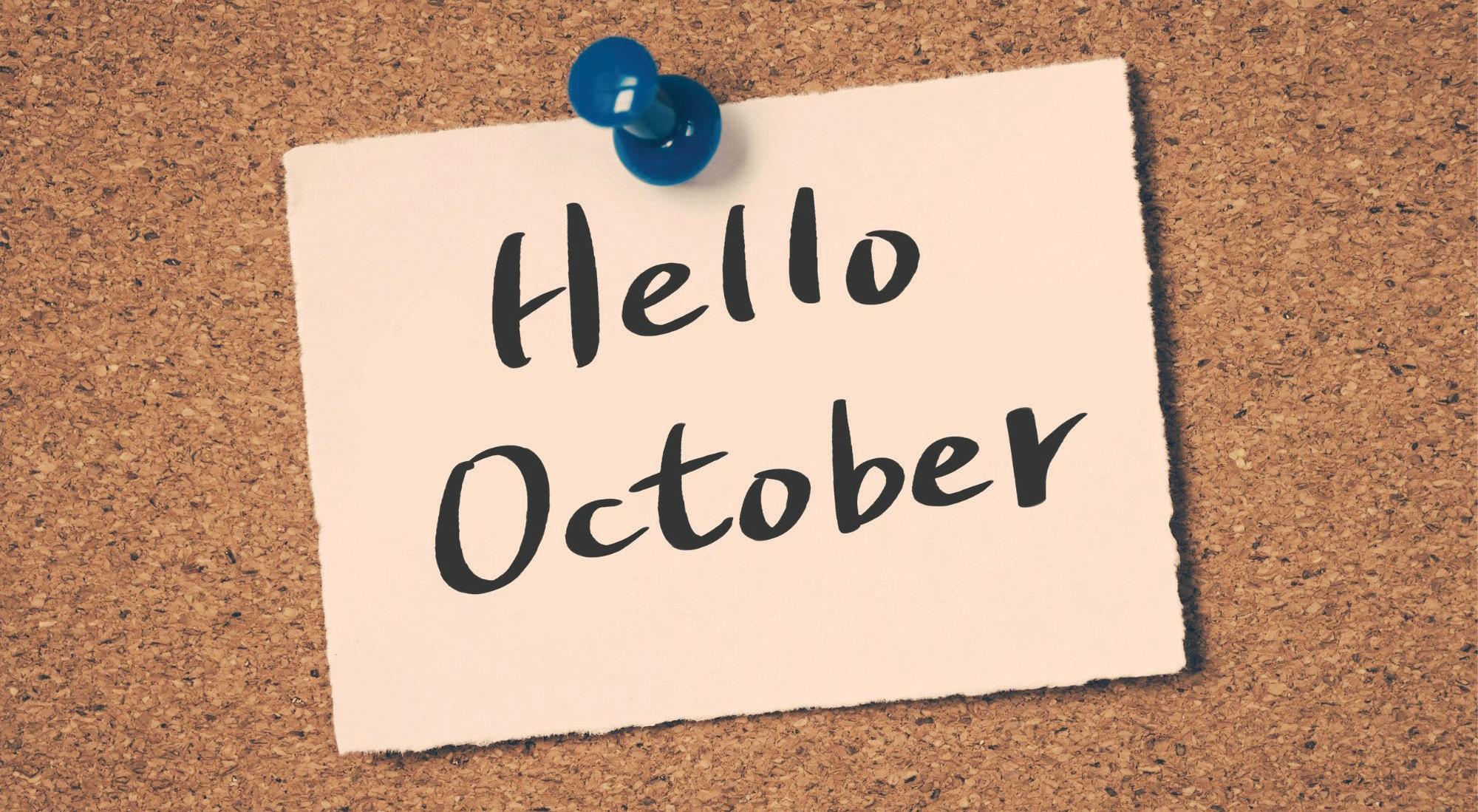
regulation to food safety, this month we’ve submitted on the Grocery Supply Code of Conduct review, proposed impost increases to imports and exports, proposed definitions of gene technology and breeding techniques and the proposed policy options for commercial infant food composition and labelling. Feedback has informed positions for upcoming agenda items at the Codex Committee for Food Labelling meeting next month in Canada and we’ve engaged with the Ministry for Primary Industries (MPI) and Food Standards Australia and New Zealand (FSANZ) on several key food related issues members have raised with us, all ensuring that industry concerns are properly considered in policy-making processes.
Sharing insights for Industry
Writing about October almost feels like I’m penning an annual report given the breadth and depth of activity. Last month, I wrote about the role NZFGC plays in advocacy, as a strong voice of FMCG, and I wanted to use this month’s column to give readers insight into our other activities.
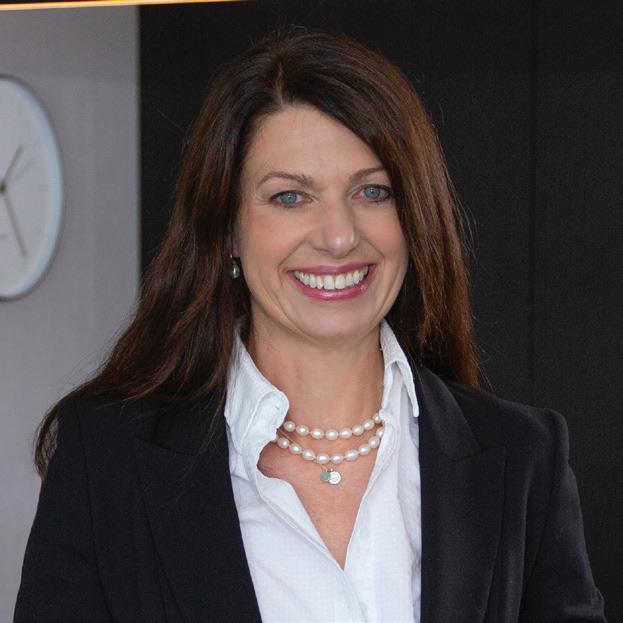
Raewyn Bleakley Chief Executive, New Zealand Food & Grocery Council
NZFGC membership is voluntary, which isn’t the case for all industry organisations, and this keeps us focused on delivering what’s in our members’ best interests and supporting them to be the best they can be.
NZFGC’s working groups have, for a long time, been pivotal as forums for discussion, advocacy and action, making a tangible impact across the industry. They’re set up to tackle key industry issues, each currently chaired by one of our board members. These include the Health
and Regulatory group, which focuses on technology, nutrition and health in relation to communications, advocacy and voluntary or regulatory policies to improve the health and wellness of New Zealanders, while our SME group brings together operators to look at smaller supplier issues. The Supply Chain group works on logistics and efficiency, how to promote industry best practice – such as our ‘Winning in Summer, Winning Together’ summer stock availability programme, while the Sustainability committee focuses on actions we can take to move towards a more circular economy, contributing to initiatives such as the Plastic Packaging Product Stewardship scheme and improving recycling and food waste outcomes. Additionally, the Talent and Diversity group fosters attraction, retention, diversity and talent development within the sector and the Industry Relations group monitors industry relationships and looks for opportunities for issues resolution. These groups ensure the NZFGC remains proactive and responsive to how our members see our industry challenges.
Our advocacy is core to NZFGC’s mission - representing food, beverage, and grocery suppliers and manufacturers through various policy-making processes. From competition
We hosted a well-attended Wholesale Supply Inquiry webinar with the Commerce Commission team, followed by a Q&A for members. Also on our agenda for October was a webinar to launch our campaign on ‘making this Summer the best stocked yet’ – supporting suppliers to plan early for steady product availability over the break. We worked with the Ministry for Women to seek views on the design for gender pay gap reporting. This tool, announced by the Government in June, aims to help businesses understand, share, and take action to close their gender pay gaps. To round off the month, we hosted a Digital Labelling Webinar with GS1 New Zealand highlighting the importance of aligning online product information with actual product labels.
Building Connections and Future Leaders
Several times a year, our Talent and Diversity Working Group hosts a Future Leaders Networking event, and this month guest speaker Lisa King, founder of AF Drinks, shared her career journey and what influenced her entrepreneurial path. It was fantastic to see such a strong turnout of emerging FMCG leaders coming together, it’s what this is all about.
While October has been a big month, just around the corner we have our biggest FMCG event of the year, NZGFC’s annual conference taking place 11-13 November in Wellington, our capital city at Tākina. But more on that in next month’s column… n





As ongoing economic uncertainty and rising costs of living reshape buyer behaviour, Oceania’s supply chains are being put to the test in new ways.
Supplied by DP World

Until recently, Oceania was a comparative baby in e-commerce terms.
With small populations dotted far beyond the main cities, its retail and consumer sectors and consumer habits as a result, have been shaped by the logistics and supply chain challenges of moving goods across vast distances.
The pandemic signalled a fundamental change for e-commerce in the region, as it did for many other sectors. Unable to go to a physical store, consumers rapidly shifted online, and Australia and New Zealand were the fastest-growing e-commerce markets in the world in 2020.
As ongoing economic uncertainty and rising costs of living reshape buyer
behaviour, once again, Oceania’s supply chains are being put to the test in new ways. Meanwhile, emerging and evolving technologies are also reconfiguring what is possible.
1. E-commerce growth is decelerating after pandemic bump
Stuck-at-home shoppers drove a vast surge in e-commerce penetration during the pandemic, particularly in Australia and New Zealand. Online shopping spend accounted for around a fifth of all retail spending in Australia in 2021 and continues to grow.
E-commerce revenue in Oceania is projected to reach US$42.70 billion in 2024 and grow to US$67.10 billion by 2029. The region still needs to catch up with other parts of the world in online spending and frequency.
In South Korea, for example, more than half of online shoppers make weekly purchases at minimum, compared to 25 percent in Australia. But the habits formed during the pandemic are now ingrained in many.
However, cost pressures, driven by inflation, cost of living increases, and other factors, have significantly impacted growth. Basket sizes shrunk in Australia in 2023, with consumers more hesitant to spend on non-essential goods and the younger generations, in particular, being more careful with their money. The country’s year-on-year growth in retail spending

dropped to two percent last year, below the pre-COVID-19 average.
2. E-commerce will exaggerate generational divides in shopping habits
How much is spent online and what it is spent on varies significantly across age groups. Fashion items dominate the online shopping baskets of Gen Z, whereas home and garden items are the most significant share for the older generations. Another divide across the age groups is seen in younger people’s greater likelihood to return items bought online.
This emerging demographic split is shaping both front-end retail strategy and back-end logistics processes. Fashion brands
such as Princess Polly are building their business models around e-commerce and buy-now-pay-later models to appeal to younger buyers.
But to serve older, omnichannel customers, big-box retailers like Target Australia still rely heavily on regional distribution centres to replenish stores. Optimising fulfilment flows and managing inventory across these diverging channels are growing logistical challenges. Our network of warehouses and facilities is designed to enable efficient inventory positioning closer to end consumers.
3. Just-in-time inventory management is here to stay
Retailers were forced to switch their inventory models to a just-in-time approach during the pandemic when supply chains struggled to keep up with demand. This model will become more embedded as many retailers look to reduce costs in an inflationary environment.
Retailers neither want to be stuck with stock that becomes obsolete nor to pay additional warehousing and storage costs. These leaner inventory levels rely on timesensitive replenishment throughout the supply chain.
Increasingly, retailers are looking for innovation from their suppliers and supply chains to increase operational precision.
Balancing the need for a stock buffer and avoiding empty shelves while containing costs has become a whole-of-supply-chain issue, and we’re helping address this in several ways – offering scalable warehousing, integrated logistics and better end-to-end supply chain visibility.
4. “Fast homewares” are gaining momentum
Lean, globalised supply chains funnelling a constant churn of new products have enabled the rise of fast fashion. Now, this model is expanding into other consumer sectors, like home goods and furnishings. There has been significant growth in lifestyle brands driven by social media, increased working from home, and other factors that have brought fashion into home styling. Several clothing brands such
as H&M and Zara have expanded into homewares, and other traditional players are under pressure to provide low-cost, stylish homeware items to cost-conscious but fashion-forward consumers.
This often involves similar tactics as fastfashion players—sourcing low-commitment, disposable pieces through flexible overseas vendors. This “fast homewares” movement puts added pressure on supply chain agility.
Compared to clothing, moving bulkier goods through logistics networks is more complicated and costly. But expectations around speed-to-market and inventory turnover remain equally unforgiving and require new approaches like our microfulfilment solutions, which put inventory at small logistics facilities, often much closer to consumers.
5. Greater technology adoption across the supply chain
Technology investment was cited as one of the biggest challenges for logistics companies in Oceania in 2023, and it’s unlikely to abate in 2024 as manufacturers and retailers increasingly prioritise supply chain visibility and traceability. From factory to front door, they aim to closely track products to manage costs, mitigate risks, and provide customers with order transparency.
Adding intelligent technology at every stage of the supply chain is at the heart of our strategy. Using automated gate systems and high-bay storage to bolster warehouse efficiency, our connected supply chains provide enhanced visibility and enable dynamic inventory management.
The growing adoption of AI and machine learning will be crucial to helping retailers navigate the growth and management of their online offerings. Technology will increasingly become a service differentiator for logistics companies, enabling deeper supply chain resiliency and visibility.
While we’ve made good progress, there’s more to come as Oceania continues to play catch-up with many other parts of the world and capitalise on the opportunities that will come to fruition as its logistics and warehousing capabilities grow alongside its e-commerce sector. n




Coles has started another chapter in its technology-led supply chain innovation journey with the official opening of its first Customer Fulfilment Centre (CFC) in Victoria. This has brought together world-class technology and automation to enhance the shopping experience for Coles Online customers in greater Melbourne.
Located just over 20 kilometres west of Melbourne’s CBD, the Truganina CFC was opened by the Victorian Acting Premier Tim Pallas MP, Coles Group Chairman James Graham, and Coles Group CEO Leah Weckert.
It was the first of two CFCs to launch this year as part of a $400 million partnership with Ocado, a global leader in online grocery transformation.
Once fully operational, the modern facility will deliver an enhanced shopping experience for online customers, with better availability, fewer substitutions, an increased range of products, and improvements in the
shelf-life of staples like mince and milk.
Coles Chief Executive Officer Leah Weckert said she was excited to see the opening of Coles’ inaugural CFC in Victoria, the first of its kind in the country.
"Today's opening signals a major step change in our online grocery deliveries that will offer our customers greater choice, better availability, improved freshness and more flexible delivery options,” said Weckert.
"We sought the best global technology to reimagine the Coles Online experience here in Australia. This transition from a local, store-based fulfilment model to a central, world-class facility will enable us to better serve the greater Melbourne region, home to
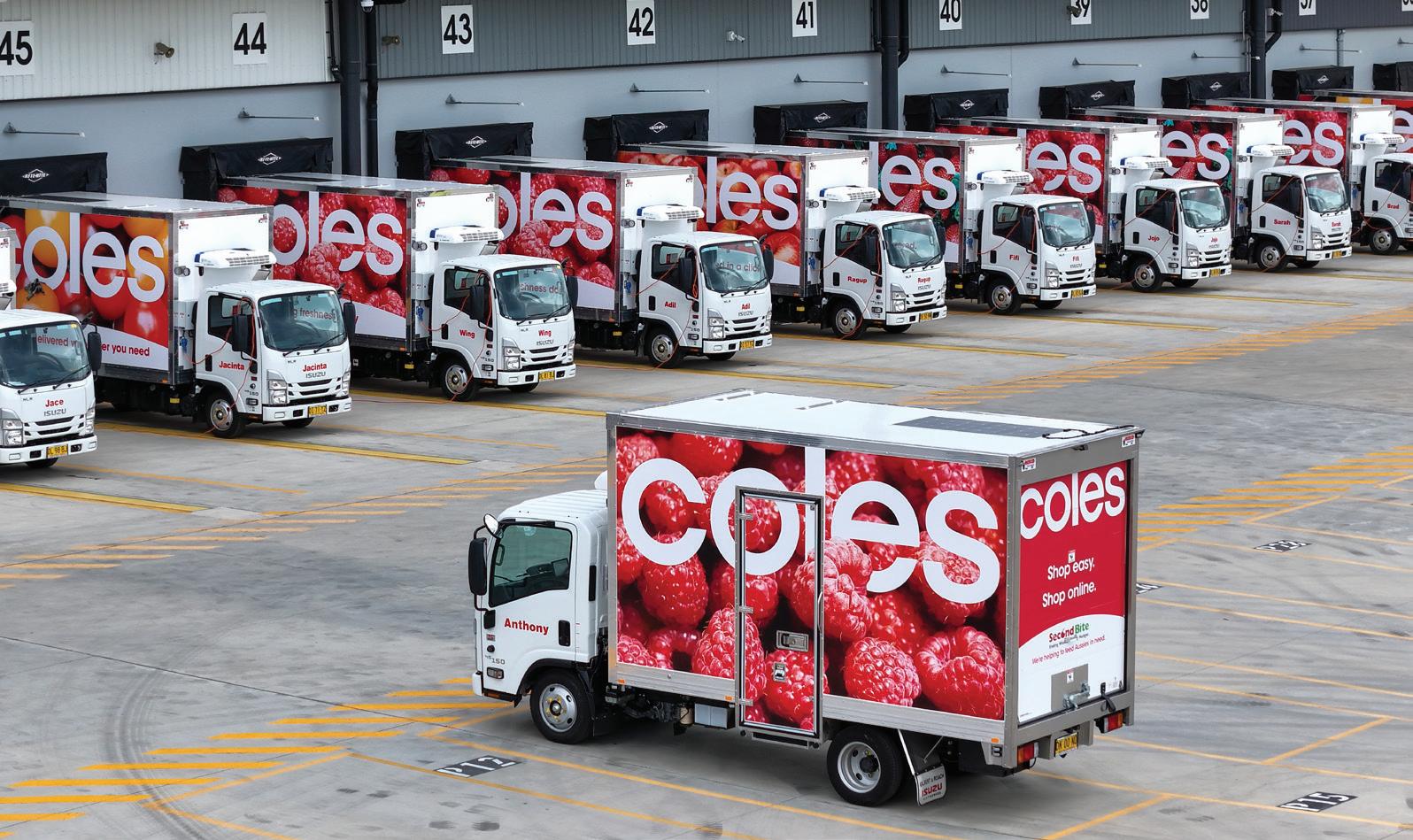

more than five million people."
The Victorian CFC’s delivery catchment will span from Ballan in the west across to Bunyip in the east, and from Beveridge in the north down to the Mornington Peninsula.
Tapping into customers' appetites for creating restaurant-quality meals at home, the CFC will house a range of specialty brands and local foods from smaller suppliers like Lello Pasta, former Flinders Lane restaurateurs.
The extended product ranges also span the health, dietary, vitamin, and baby categories. There is also an on-site bakery that will bake to order twice daily and a fresh produce area where produce will be cut and packaged to order, leading to less wastage.
Customers will also have the choice of extended delivery windows from 5 am to 10 pm, with later cut-offs for both next day deliveries in the morning and evening.
The CFC will use cutting-edge Ocado technology, utilising artificial intelligence, advanced robotics and automation to transform the way Coles Online orders are picked, packed and delivered.
The Truganina site has a footprint of more than 87,000 square metres, four times the size of the Melbourne Cricket Ground. It can hold three million units of stock and process more than 10,000 customer orders per day when running at full capacity.
The state-of-the-art site features a centralised hub, known as ‘The Hive’, where a fleet of more than 700 bots will fulfill a customer order containing 50 items

in just five minutes, while an artificial intelligence ‘air traffic’ control system will oversee the bots as they move around giant 3D grids, transporting containers of grocery items to be packed and delivered by Coles team members.
The CFC will employ more than 1,000 team members, including drivers and fulfilment roles that will use high-tech packing equipment, and there will be a fleet of more than 200 home delivery vans specially designed with dual compartments to ensure fresher products while reducing emissions and a side door to make it easier and safer for delivery drivers to unload.
Delivery times will also be improved, with Ocado’s technology giving Coles the ability to calculate the most efficient routes based on real-time conditions and tonnage of the home delivery vans.
Coles Group Chairman James Graham said he was proud to see another significant investment in Coles’ technology strategy come to life.
“The opening of this CFC is the result of a five-year partnership with Ocado, whose world-class experience is helping Coles to innovate and meet the changing needs of our customers,” said Graham.
“It’s been a significant 18 months for Coles Group with the opening of two automated distribution centres in Kemps Creek, New South Wales and Redbank, Queensland. Coupled with today’s launch of the first of two CFCs, we’ve made meaningful progress in our commitment to using the best technology to drive

The opening of this CFC is the result of a five-year partnership with Ocado, whose world-class experience is helping Coles to innovate and meet the changing needs of our customers,
supply chain innovation.”
The Truganina CFC has been designed to support best practices in sustainability.
The site includes a two-megawatt solar installation, sensor lighting, a water recycling system, and 100 percent cardboard recycling.
“It’s a great moment for Ocado as we mark the start of our operations here in Australia with Coles. This is one of the fastest growing markets in the world for grocery ecommerce, and Coles is already a market leader in the online channel,” said CEO of Ocado Group Tim Steiner
“As these CFCs ramp up both here in Victoria and in New South Wales, Coles Online customers in metropolitan Melbourne and Sydney will get to experience a game-changing difference in the quality of service available online.”
This opening will be followed by a second
CFC site in Wetherill Park, New South Wales.
Coles thanked its building partners and consultants from Charter Hall, FDC, TMX and Accenture for developing, building and managing the complex Truganina building project to completion.
The Truganina CFC is proudly named Brungilo Curran, meaning Stringybark Gum Tree.
The site of the Truganina CFC, Brungilo Curran, is home to the Bunurong People. Coles recognises the importance of developing a relationship with the people of Bunurong Country where Coles has established operations.
The name and associated artwork at the Truganina CFC were developed through consultation with local Bunurong community and local artist Kobi Sainty. n





Foodstuffs North Island and Foodstuffs South Island each have their own support centres where experts advise co-operative members on everything they need to run their stores, including IT, AI, and retail innovation.
AI plays a key role in enhancing our customers' shopping experience. By analysing what people have bought before, what they’re browsing, and their preferences, we can tailor marketing offers and product recommendations that feel relevant to them.
In addition, AI helps with meal planning by suggesting recipes that match customers' shopping history and dietary needs. With ‘shoppable meal recipes,’ customers can add all the ingredients they need to their basket with just one click, making it super easy to get everything sorted for dinner.
We’re also using AI to improve how we fulfil online orders. AI helps calculate the quickest route through the store for our
team members, making sure they pick items efficiently and accurately. This means orders get to customers faster and with fewer mistakes.
AI is not new to our supply chain. It helps us forecast demand much more accurately by looking at historical data, seasonal trends, and current sales patterns. It also helps us ensure we have the right amount of stock in stores, cutting down on waste from over-ordering and ensuring we don’t run out of popular items.
In today's fast-paced retail environment, AI is helping us keep shelves stocked, reduce waste, and enhance the customer experience. Foodstuffs South Island has implemented SAP Unified Demand
they act as champions for ai and support our team members in adopting these new tools safely and securely.
Forecasting (UDF), an AI-driven tool, to tackle the challenge of managing diverse products in a changing market.
With fewer manual steps, we can react faster to market changes and keep everything running smoothly. This not only reduces inefficiencies but also keeps our shelves stocked when and where they’re needed.
Traditional forecasting often led to overstocking or understocking. UDF can now incorporate historical data, local events, weather patterns, and learnings from similar stores, making our forecasts more dynamic and precise. This innovation improves operational efficiency, allowing us to predict demand better and lead the way in retail innovation.
However, scaling AI across large organisations like ours isn’t without challenges.
One of the biggest hurdles is making sure we’ve connected our data with our people across all our systems and that the quality of the data is fit for purpose. AI is only as good as the data it’s working with, so if the data is inconsistent or unreliable, this will be true for the ‘insights’ generated through it.
We’re tackling this by investing in strong data governance and ensuring all areas have access to clean, unified data. This is a journey and will enable us to set a solid foundation for AI to perform at its best across all areas of the business and helps us scale it more effectively.
One of the main barriers is finding out how best to integrate AI in our stores quickly to deliver clear value. Demonstrating early wins, like improving efficiency or cutting costs, is important to build trust and attract further investment in AI projects.
On the people side, a big challenge is getting everyone on board with AI, especially if they’re unfamiliar with it.
We’re working on improving AI and data savviness across the business by running awareness-raising campaigns, providing training and fostering a culture that embraces data-driven decision-making.
Our Data and Analytics team, along with members of the broader IT team, plays a key role here. They act as champions for AI and support our team members in adopting these new tools safely and securely.
Relevant to all of our work in the AI space is the development of our policies, standards, and guidelines on the safe and ethical use of AI. This ensures that our AI development is compliant with any applicable regulations and meets the privacy standards our customers would expect of us. n






Amazon has announced AI Shopping Guides, product guides that pair helpful information about a product type with Amazon’s expansive selection, making it easier for customers to find the right product for their needs.
AI Shopping Guides have been made available to all U.S. customers in the Amazon Shopping app and Amazon’s mobile website.
Powered by Amazon’s powerful generative AI capabilities, AI Shopping Guides act like a trusted product expert by proactively consolidating key information customers need to make an informed purchase.
Now rolling out to more than 100 product types, each AI Shopping Guide explains key features to consider for a specific product type, must-know terminology, and trusted brands alongside product recommendations based on a customer’s needs.
“When shopping for a new product, it can be difficult to understand the options




available or know the right questions to ask,” said Dan Lloyd, vice president of personalisation at Amazon.
“With AI Shopping Guides, we’re pairing helpful product information and guidance with Earth’s largest selection to help customers understand a product type, discover the most trusted brands, and find the best product for their needs.”
AI Shopping Guides take the guesswork out of shopping for new products and provide insights at customers’ fingertips.
For example, when shopping for a new face moisturiser, customers can select their skin type and learn what suits their needs. With Rufus, Amazon’s generative AIpowered shopping assistant, customers can quickly receive answers to any additional questions that come up as they shop.
The information needed to make an informed purchase decision varies significantly between product types, and it also constantly changes with new technologies, product features, trends, and customer insights.
Generative AI has enabled Amazon to scale AI Shopping Guides across its vast
selection. Large language models (LLMs) uncover the most helpful attributes, use cases, features, brands, and terminology for each product type from its catalogue data and continually ensure that information is current and relevant.
The LLMs then generate tailored guide descriptions based on this information and product recommendations. AI Shopping Guides were built using Amazon Bedrock, which provides scalable access to the latest foundation models and AI tools, making it the most efficient way to build and scale generative AI applications.
“It’s early days, but we believe AI Shopping Guides will improve how customers discover, explore, and stay informed about the products they want and need. We’re excited to continue enhancing the shopping experience with practical, useful AI innovations so customers can feel confident in their purchases.”
Customers can see AI Shopping Guides in search autocomplete suggestions or by clicking the “Keep Shopping For” tab on the Amazon homepage. n





In the ever-evolving retail landscape, the demands of consumers are rapidly changing, and supermarkets must not only innovate for the digital age but also leverage technologies like AI to keep up with demand.
According to the latest EY Future Consumer Index, 95 percent of New Zealand consumers are either cautious, concerned or downright pessimistic about their current financial outlook, which is having a flow-on effect on how and where they spend.
With consumers' growing financial concerns, it’s critical that supermarkets optimise their supply chains and customer service offerings.
New Zealand’s supply chain and logistics challenge – a small population stretched across two long, thin islands at the bottom of the world – is undeniably a hard nut to crack. Despite the challenges, customers have high expectations for swift delivery, with 20 percent citing slow shipping as a deterrent for future online purchases.
Some retailers already use AI to standardise processes, optimise last-kilometre delivery and improve the customer experience. EY studies showed AI adoption at 62 percent globally in supply chain sustainability tracking and measurement, and 40 percent of supply chain organisations are investing in Generative AI.
By analysing purchasing trends and consumer behaviour, AI allows supermarkets to fine-tune their supply chains in real-time, minimising over- and under-stocking.
Using Gen AI, supply chain leaders can classify and categorise information, quickly analyse and modify strategies based on realtime data, summarise large volumes of data, and integrate AI into the building blocks of supply chain operations – plan, source, make and move.
Utilising AI in supply chain management will improve operational efficiency and reduce food waste. This issue is of growing importance for Kiwi consumers, with 86 percent believing wasting food is wrong and increasingly factoring sustainability into their shopping decisions.
AI has proven to be a game changer for customer experience, both online and instore.
AI can also personalise the online shopping experience. Personalised promotions, product purchase reminders, and automated responses are among the most trusted applications for Kiwi consumers.
ai has proven to be transformative, but much like any new technology, it needs to be used correctly, with the right controls and understanding in place.

A significant 58 percent of consumers exposed to AI while shopping online report that it has improved, at least a little, their shopping experience. Recommending products based on previous purchases not only improves customer satisfaction but also increases basket sizes.
AI-driven chatbots and virtual assistants are also transforming customer service. They offer real-time support, answer queries, and resolve issues quickly, making the shopping experience more seamless both online and
However, implementing AI in customerfacing roles is not without its hurdles. Supermarkets should ensure their AI integration is user-friendly, continuously updated, and integrated with human customer service agents for more complex

Building trust in a datadriven model
As supermarkets embrace AI, they must also navigate the challenges of data privacy and integration. While customers have grown more comfortable and aware that their personal data is being captured, the rapid emergence and use of Gen AI have impacted confidence
Sixty-one percent of Kiwis state they are paying more attention to which brands and companies they share their data with. Transparency is critical, so supermarkets must ensure robust protections and communicate how customer data is used to enhance shopping experiences.
For AI, development has so far outpaced legislative action, so organisations integrating AI into their systems and processes should proactively develop an ethicsbased framework to follow compliance and
reassure consumer fears.
Building consumer trust and loyalty is another key challenge for supermarkets in New Zealand. With 95 percent of consumers interested in loyalty programs that offer a meaningful value exchange, AI-driven loyalty schemes represent a significant opportunity. These programs can help build long-term relationships by offering personalised rewards, drawing consumers to spend more or buying select items to receive the rewards.
As supermarkets look to the future, AI will enable greater efficiency, enhance customer engagement, and help businesses meet consumers' demands. By embracing AI, supermarkets can not only weather today’s economic pressures but also create more meaningful and satisfying experiences for their customers in an effort to build long-term loyalty.
AI has proven to be transformative, but much like any new technology, it needs to be used correctly, with the right controls and understanding in place. It also requires organisations to have a baseline and consider use cases before implementing. What use is AI if you operate on a technology platform that is unsuitable for purpose or at the end of life? Or if organisational maturity and capabilities related to customer experience are low?
AI already offers a glimpse of the extraordinary, but it may not be the silver bullet or shortcut to success for every use case that many hope for. Fundamentals remain exactly that—fundamental. n






Walmart unveiled its strategy to accelerate Adaptive Retail, the new era of retail defined by personal experiences that have brought customised shopping to customers.

The company revealed proprietary artificial intelligence (AI), Generative AI (GenAI), Augmented Reality (AR) and Immersive Commerce platforms it has leveraged to create hyper-personalised, convenient and engaging shopping experiences across Walmart stores, Sam’s Clubs, apps and other virtual environments.
“A standard search bar is no longer the fastest path to purchase; we must use technology to adapt to customers’ preferences and needs,” said Suresh Kumar, global chief technology officer and chief development officer at Walmart Inc.
“At the heart of our platform strategy is developing common global core capabilities built once and deployed across Walmart U.S., Sam’s Club and Walmart International.
As a global company with multiple business segments, this enables us to move quickly as we bring consistent experiences to all our customers and members.”
Walmart has developed a system of proprietary GenAI platforms, the latest of which is Wallaby, a series of retail-specific LLMs primarily used to create customerfacing experiences.
Wallaby has been trained with decades of Walmart data, enabling Walmart to combine it with other LLMs to create highly contextual responses tailored to the Walmart environment. It is also trained to respond in a natural tone that aligns with Walmart’s core values.
With a combination of GenAI platforms, Walmart has also created a more personalised version of its AI-powered Customer Support Assistant. This recognises who the customer is right from the start and goes beyond just understanding the customer’s intent to take actions, like finding orders and managing returns.
In testing, customers reported a smoother experience that helped them handle their issues quickly and independently. The company has been actively building dozens of additional GenAI tools for customers, members, associates, and partners to leverage its GenAI platforms, including enhanced care assistants for Sam’s Club and Walmart International.
Customers crave personalised shopping experiences, and Walmart’s Content Decision Platform, aligned with its Digital Trust Commitments and Responsible AI Pledge, is a foundational tool to create shopping experiences tailored to the individual customer.
The platform has leveraged AI-based technology to understand the customer and a GenAI-powered tool that can predict the type of content they’d like to see on the site. With this technology, Walmart will create a unique homepage for each shopper, making the online shopping experience as personalised as stepping into a store designed exclusively for each customer.
The U.S. experience has been expected
to launch by the end of next year, and the company has planned to also use the platform’s underlying technology in Walmart International’s Canada and Mexico markets for personalised item recommendations, setting a new standard in global retail.
Today's retail has gone beyond online and in-store shopping or a combination. It has become about meeting customers in new places, particularly younger generations for whom shopping is often a byproduct of other activities, like gaming.
To do this, Walmart has developed an AR platform, Retina, which leveraged AI, GenAI and automation to create tens of thousands of 3D assets, along with Immersive Commerce APIs. These technologies enable the company to bring the Walmart shopping experience into new virtual social environments.
Following its success as the first major retailer to pilot real-world commerce on Roblox and launch Walmart Realm, an immersive commerce destination, Walmart has used its Immersive Commerce APIs to enter alpha testing with Unity.
The company will also use its Immersive Commerce APIs to launch a new experience with ZEPETO later this year. Within the immersive avatar-based social platform, customers can buy items from Walmart’s No Boundaries brand for virtual avatars and match real-world items for themselves.
“Being people-led means we start with the human need, and often, a combination of technologies like AI, GenAI, AR and Immersive Commerce is key to the solution. Our customers guide us; with these platforms, we’re ready for whatever they need.”
Looking ahead, Walmart has planned to bring View in Your Home to Canada, Mexico and Chile via Retina and create more interactive experiences, like “hotspots,” an extension that enables customers/members to access production information while viewing an item in 3D. The company has also been actively working on headset-based experiences to enable customers/members to visualise furniture in an inspirational setting. n





In the fast-paced environment of supermarkets and grocery stores, staff members are constantly on their feet, ensuring that shelves are stocked, customers are assisted, and operations run smoothly.

Amidst this hustle and bustle, it's crucial to provide employees with opportunities to take calming breaks. Here's what happens when supermarket staff take a break in a calming environment:
Stress Reduction:
Spending time in a calming environment, such as a nature setting or a quiet break room, can significantly reduce stress levels. Research has shown that even a 20-minute break in nature can lower cortisol levels, the stress hormone, leading to a more relaxed state. This reduction in stress helps to calm the central nervous system and shift brain states, promoting overall mental health.
Improved Mood and Mental Health:
Calming environments can improve mood and alleviate symptoms of anxiety and

depression. Exposure to nature, for example, has been found to regulate the sympathetic nervous system, which is responsible for the body's stress response. This can lead to immediate benefits, such as lower blood pressure and heart rate, and long-term benefits, such as reduced risk of chronic mental health conditions.
Enhanced Cognitive Function:
Taking breaks in a calming environment can also boost cognitive function. Relaxing activities like walking, meditation, or simply being in nature can improve attention span, memory, and overall cognitive performance. This is because these activities allow the brain to rest and recover from the demands of work, leading to better focus and productivity when returning to tasks.
Increased Creativity and Problem-Solving:
Calming environments can stimulate creativity and enhance problem-solving abilities. When the mind is relaxed and free from stress, it is more open to new ideas and innovative thinking. This can lead to improved performance and more effective solutions to on-the-go challenges faced in the supermarket environment.
To maximise the benefits of calming breaks, it's essential to create a welldesigned break room. We don’t always have the liberty of outdoor access to landscaped spaces, so we can look to ways to incorporate planter boxes, organic shapes, and natural materials into break room furniture and fitouts. Comfortable and inviting furniture can make a significant
difference in how employees feel during their breaks. Consider incorporating lounge chairs, dining tables, and quiet corners with plush seating to cater to different preferences and needs. Considered furniture choices can not only enhances comfort but also add to the overall aesthetic appeal of the space, making it a more inviting place for employees to relax and recharge.
Taking a break in a calming environment can lead to reduced stress, improved mood, enhanced cognitive function and increased creativity and problem solving. These benefits highlight the importance of incorporating calming breaks into the daily routines of supermarket staff to support overall well-being and productivity. By providing employees with opportunities to recharge and refresh, and by investing in comfortable and stylish furniture, supermarkets can create a more engaged, motivated, and productive workforce.
Are you ready to invest in your staff spaces and boost team wellbeing?
Talk to Harrows today about staff cafeteria furniture – beautiful tailored furniture for social interaction. n
0800 142 233 | harrows.co.nz







ADF Foods
ADF Foods, a fourth-generation family-owned leader in gourmet Indian cuisine, announced its availability in the frozen aisle.
The Truly Indian Tandoori Naan will now be available in the frozen bread aisle of all Whole Foods Market stores. This has marked the first time Whole Foods Market will carry frozen naan, bringing a new level of authenticity and convenience to American households.
VEGAN NUTELLA Ferrero
Ferrero has announced the launch of its global spread in a new plant-based version.
As the latest addition to the growing family of Nutella products, Nutella Plant-Based delivers the same unmistakable Nutella experience without milk and adds vegetal ingredients such as chickpeas and rice syrup.


Philadelphia
Philadelphia has brought its signature creamy taste to the baking category.
Philadelphia has launched the Philadelphia Cream Cheese Flavoured Frosting. Made with fresh milk and real cream, Philadelphia Frosting is the first refrigerated cream cheese frosting from a mainstream brand in the U.S.

BERO is a premium, non-alcoholic beer created by Tom Holland, not as a substitute but as a new gold standard in beer. Created along with Grant Wood, who has over 40 years of experience as a brewmaster at some of the world's most prestigious breweries, BERO is the beverage of friendship. It is available in three dynamic styles: Kingston Golden Pils, Edge Hill Hazy IPA, and Noon Wheat.

Coca-Cola and Bacardi
The Coca-Cola Company and Bacardi Limited agreed to debut BACARDÍ rum and Coca-Cola as a ready-to-drink (RTD) premixed cocktail.
BACARDÍ Mixed with CocaCola RTD will be available in several markets worldwide. The initial launch has been planned for select European markets and Mexico in 2025.
“We are continuing to develop our portfolio as a total beverage company, including in the growing alcohol ready-to-drink market,” said James Quincey, Chairman and CEO of The Coca-Cola Company.
A.1.
A.1., known for its iconic steak sauce, has gone beyond the condiment aisle with the debut of A.1. Steakhouse Butter.
Marking the brand’s first innovation outside the sauce bottle in over five years, A.1. Steakhouse Butter combines delicious authentic steakhouse-inspired flavours and a buttery, creamy texture, elevating grill enthusiasts’ favourite meals.


Gatorade
Gatorade announced the launch of Gatorade Hydration Booster, a new electrolyte drink mix designed to be the perfect all-day hydration hero. Gatorade Hydration Booster is the brand's first electrolyte powder, developed specifically for people's everyday lifestyles. Its advanced blend of electrolytes from watermelon juice, sea salt, sodium citrate, and potassium salt is backed by the Gatorade Sports Science Institute for all-day, alwayson hydration.


Bosistos
Bosistos has launched two new laundry capsule varieties: Sensitive Laundry Capsules and Power+ Laundry Capsules in packs of 20.
Experience a fresher clean with these gentle formulas containing naturally derived ingredients, including pure eucalyptus oil grown on the farm in Inglewood, Victoria, Dja Dja Wurrung country. Bosisto’s Sensitive Laundry Capsules are tough on stains but proven kind on sensitive skin, while the Power+ Laundry Capsules have a 6x enzyme-boosted formula and leave clothes fresh.






Cadbury

Tilda Kids
A fruity rice pudding with bananas and strawberries counts as one of five a day. The new Tilda Kids Vanilla Rice Pudding is the perfect cupboard essential for a quick and easy snack or after-dinner treat. Warm it up or eat it cold; it's delicious at any temperature, on its own, or with fresh fruit. It is also dairy-free, gluten-free and vegan.
Made to capture the essence of the classic Tiramisu dessert, this special edition chocolate slab is a tempting option for those who enjoy dessert-inspired confections. It is versatile enough to enjoy on its own, as a topping for ice cream or sprinkled over desserts to enhance their flavour. Whether enjoyed alone or shared during a movie night, each block provides a moment of pure joy.
Califia Farms
This limited-edition plant-based creamer blends the flavours of fluffy waffles, sweet maple syrup, and creamy almond milk with 25 percent less sugar than other leading plantbased creamer brands.


Twisties
Seek your fortune with the NEW limited edition Sweet n’ Sour Fortune Twisties. Customers can open the delicious pack of fortune twisties, scan the QR code and open the meta filter. Reveal the Twisted Fate... will it be sweet or sour?


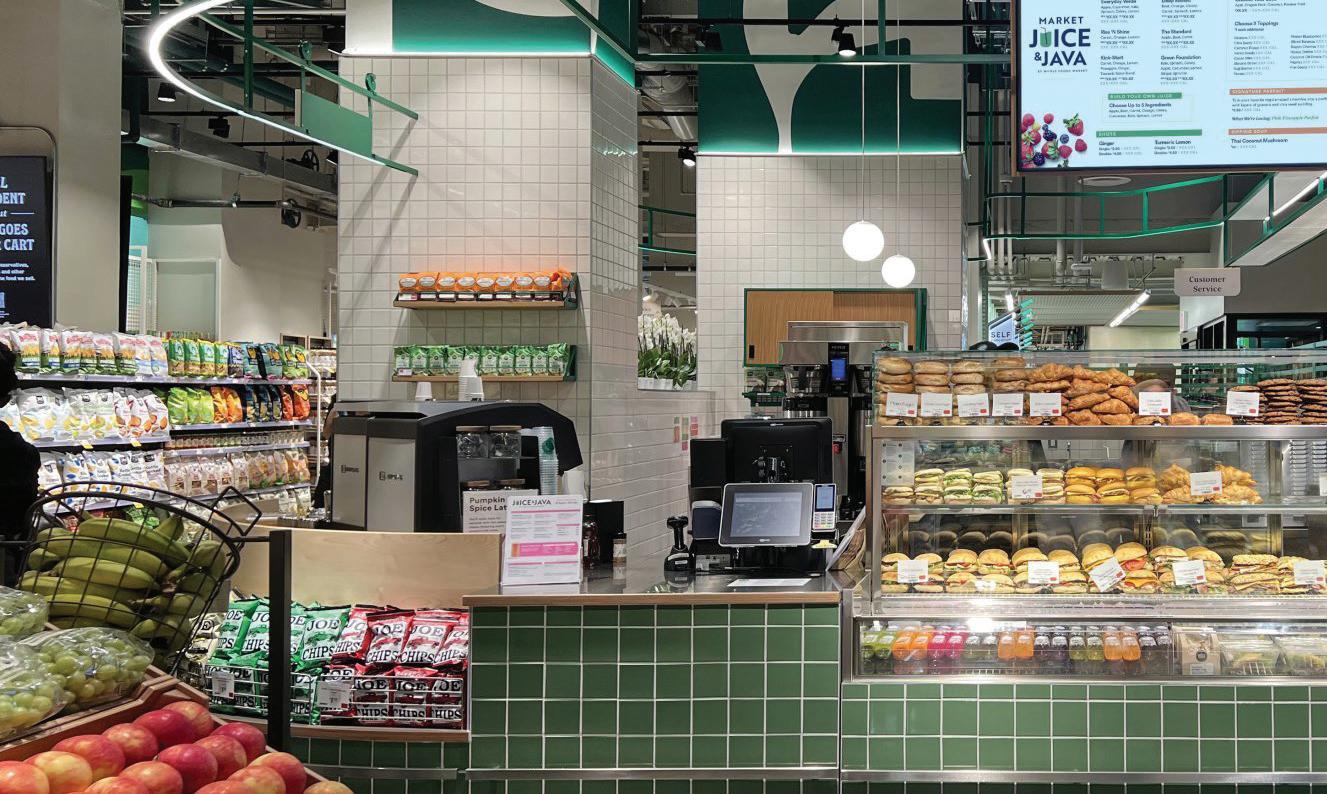


Schweitzer has announced the world’s leading natural retailer, Whole Foods

announced its collaboration with natural and organic foods Foods Market Inc.

Schweitzer has announced its collaboration with the world’s leading natural and organic foods retailer, Whole Foods Market Inc.
This partnership involves the development of a new store format - the Whole Foods Market Daily Shop.
The quick-shop stores, which range between 7,000 and 14,000 square feet, will pave the way for expansion in dense metropolitan areas.
The prototype store opened its doors to customers last month in Manhattan, New York.
Whole Foods Market Daily Shop will provide a convenient option for grab-andgo meals and snacks, weekly essentials, and a quick, easy destination to pick up ingredients to complete a meal - all based on an all-organic product offer.
Schweitzer and its sister agency, Interstore, oversee the development of the store concept and the fit-out of the actual market.
The project also involves the introduction of custom-made refrigeration, which is produced at Schweitzer production sites in Italy. This state-of-the-art cooling technology allows display cases and counters to be quickly connected and removed without affecting the rest of the circuit. Furthermore, 90 percent of the refrigeration furniture can be connected to a Waterloop refrigeration system.
The cooling units have been custom-made for and designed with the client, both to achieve an impeccable product presentation and to fit all the store’s requirements, as well as for future rollouts.
The goal of the store concept was to provide our client with a flexible space that
is easily and rapidly adaptable to changing seasons, trends, and consumer needs. Hence, a design concept was developed based on achieving the maximum output with a minimum input in terms of material usage.
The color palette plays with the client’s corporate colors green and white as well as the graphics on the walls support the friendly and approachable look and feel of the store. With the substance of the space basically unchanged, brick walls and wooden elements in their simplicity emphasize the successful product presentation. The whole store concept aims at making the product the king.
The lighting concept, elaborated with partner Imoon, uses spotlights to accent selected products and give them a bigger stage to catch the customer’s attention.
This new store format for daily shopping features a targeted product offer with everything from fruit and vegetables, fresh bread, dairy and frozen products, easy meals and snacks, beauty products, and flowers. It is the go-to neighbourhood market for the quick stop on the way home or the weekly grocery shopping trip.
In the months to come two more stores will follow in Manhattan, New York. n





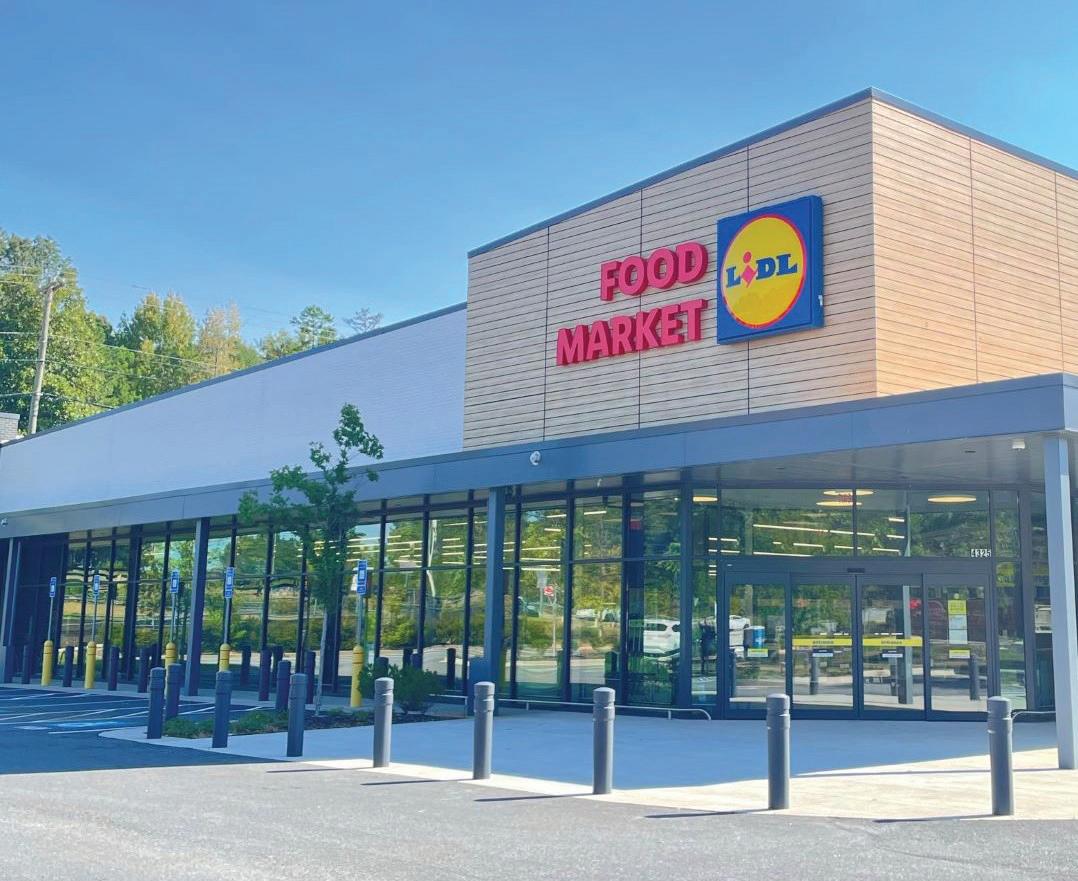
Lidl US opened its newest store in Cumming, Georgia, operating daily. The ribbon-cutting event was followed by a grand opening celebration featuring special offers for shoppers.
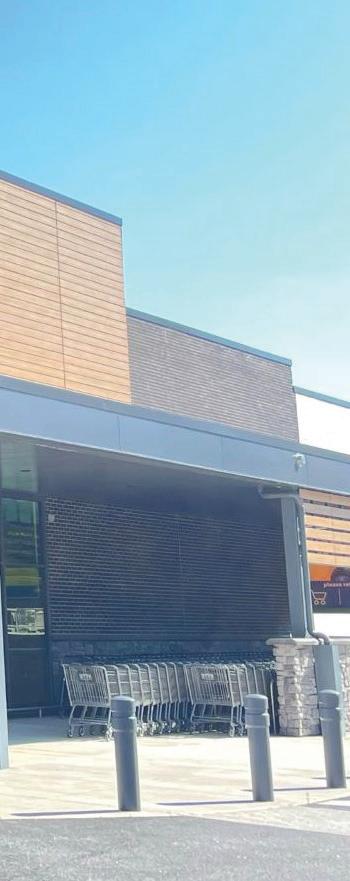
The new location is part of Lidl US’s growing store network in the Atlanta area. Other nearby Lidl US stores in Georgia include Suwanee, Roswell, Duluth, and more.
This Lidl US store also created approximately 30 new jobs. A 2024 Top Employer, Lidl US has provided comprehensive benefits, including healthcare, for all full- and part-time positions, regardless of hours worked per week.
At the grand opening event, the first 100 customers in line before the store opened at 8:00 a.m. received a special gift card ranging from $5 to $100 each. Shoppers also sampled Lidl US’ award-winning assortment and took advantage of special giveaways.
The store also donated $1 for each shopper who signed up for the myLidl app and set Cumming as their store throughout the opening weekend.
WE'RE TAILORING PRODUCT OFFERINGS TO BETTER MEET CONSUMER NEEDS, LIKE INTRODUCING NEW BAKERY ITEMS THAT AMERICANS EXPECT (FRESHLY BAKED NEW YORK BAGELS AND MUFFINS) IN ADDITION TO OUR BELOVED STAPLES (CROISSANTS).
“Lidl US is in the midst of a strategic transformation. We’re focusing on creating the best customer experience in-store – from the produce section to the checkout,” said a Lidl US spokesperson.
“We’re tailoring product offerings to better meet consumer needs, like introducing new bakery items that Americans expect (freshly baked New York Bagels and muffins) in addition to our beloved staples (croissants).”
They added that they were also internally focused on teams with new development initiatives to ensure everyone from the stores to offices felt supported and valued.
Lidl US is known for fresh – everything from bakery items to produce.
“Our teams are constantly on the lookout for standout items, making sure that our customers get the freshest produce, meats, fish and baked goods. In fact, we even dropped the price on one of our most popular items – our croissant. Now, you can get a freshly baked French croissant for only $0.49.”
Many have repeatedly ranked Lidl US among the top grocers in the country. At Lidl US, shoppers can expect a world-class shopping experience where they will save time and money each week with its highquality and low-cost assortment.
These include private label products that help shoppers save up to 40 percent compared to their national brand counterparts, healthy, responsible choices,
including hundreds of organic and glutenfree products, specialty items ranging from hard-to-find cheeses to authentic specialty sauces, cured meats, and more.
Keeping up with its commitment to fresh food, the new store will bring in fresh produce each day, with over 100 highquality options. Flowers are guaranteed to be fresh and beautiful for five days at minimum, with roses and lilies guaranteed for seven days.
Freshly baked breads and pastries will be baked and restocked throughout the day, and new fresh protein offerings will include organic and grass-fed options.
“Our customers also love our non-food section, or what we call the Midl-of-Lidl. Customers can find everything from workout clothes to Halloween decorations – it’s a treasure trove of fun with new items added every Wednesday.”
The store will also offer customers a seamless shopping experience. Its easy-toshop layout makes shopping faster and more convenient. The Lidl Love It Guarantee is a logo that guarantees customer satisfaction; shoppers love the product they buy— or they are entitled to a refund and a replacement.
Other personalised offerings will also be available, including new and exciting products and recipe inspiration aligned with what is in shoppers’ baskets. n




Soft drink company Karma Drinks is excited to announce a new sugar-free offering that’s set to soon hit the NZ supermarket shelves.
Introducing… a sugar-free Lemmy (lemonade) drink, launched in August to compliment the sugar-free cola already on the market.
Karma senior brand manager Imogen Weir says the new offering is in response to a recognised keenness amongst consumers to reduce their sugar intake and enjoy products that benefit their health.
“Lemmy is our number one seller in New Zealand, so it made sense to create a sugar-free version. The market has seen a lot of growth in the ‘better for you’ category, which includes low calorie and sugarfree product. And so, we are excited to launch our innovative Lemmy answer to that,” Imogen says.
The new product is in line with the company’s branding of: Karma tastes better, does better, and is better, Imogen says, and is a good fit for Karma’s “The power of positive drinking” messaging.
New Zealanders can already buy the new Lemmy offering at selected retailers such as Farro and from the Karma website. It is set to hit supermarket shelves in the lead up to summer.
In addition, Karma’s popular sugar-free cola (already in the NZ, United Kingdom and Australian markets) has had some “formulation changes. The next step will be to launch sugarfree Lemmy into the UK market, Imogen says.
The Lemmy launch is but one aspect of good news celebrated at Karma Drinks of late, both at home and abroad.
Karma Drinks has just taken out a top award at a prestigious UK enterprise event, winning
the SME News-UK Enterprise Award for Best Ethical Drinks Brand 2024.
It was acknowledged at the event that the Karma team: “knew that they had to do more than create soft drinks that just tasted good to succeed in this crowded market. By creating a company that is proud to be Fair Trade, certified as organic (by the Soil Association), and the top scoring soft drink B-corp in the UK, they have done just that. The small team that make up Karma Drinks all align with the values that the business has been built on… namely, humanity, impact and respect.”
The competition judges acknowledged that Karma Drinks not only uses organic, vegan and Fairtrade ingredients across its range, it also takes responsibility for improving the lives of growers and suppliers and preserving precious natural resources. The company is trucking along in its endeavours to become the most ethical soft drink brand in the world.

Furthermore, the SME News publication (which focuses on a Uk-wide network of industry insiders) stated: “Karma Drinks knows it cannot take on the giants of the soft drink game, but what it can do is bet the best version of itself, crafting genuine connections with those who source its ingredients – making a small effort that contributes immensely to the bigger picture.”
Imogen says the comments above are in line with Karma’s recently released 20232024 impact report. It’s a great document, she says, to take to our consumers, and for the Karma team to have as a reminder of the company’s “why”.
“It’s good for consumers to understand that, when they buy and drink Karma it’s like everyday activism as they are having a positive impact and are giving back to the community and
land where we grow. We invest in the places where we source our product.”
The Karma Foundation has ensured Karma Drinks is “a force for good”.
Karma Drinks Foundation chairman Albert Tucker is proud of the positive impact achieved in 2023, which has involved the enhancement of the lives of growers and ecology protection in regions where Karma ingredients are sourced. He says the company is committed to further progress in the years to come.
A full copy of the impact report is available on the Karma website https:// karmadrinks.co.nz/pages/the-people
In brief, the report states that over the last year, Karma initiatives have provided vital support to over 1,000 farming families.
“By ensuring fair trade practices and offering premium prices for their crops, we have helped improve their livelihoods and economic stability. Our investment in community projects has facilitated the construction of new schools, ensuring that children in these communities have access to quality education.
“We have also supported healthcare initiatives, providing essential medical supplies and health education to improve the overall well-being of these communities. Ecologically, our sustainable farming practices have led to the conservation of local biodiversity. We have worked closely with farmers to implement agro-forestry techniques, which enhance soil health to create a more resilient agricultural ecosystem.
“Our efforts in reforestation and organic farming methods have significantly reduced the carbon footprint of our supply chain, contributing to global efforts to combat climate change.”
All up, as Karma Drinks enters the final sector of 2024 there is, inarguably, much to celebrate…plenty that’s good (better, in fact) to drink to. n
Column Supplied by NZ Beverage Council


As consumers have begun to seek smaller, more frequent meals throughout the day, the snacking category has seen much growth. Addressing this trend, Magnum recently launched its first bite-sized Bon Bons and joined Ben & Jerry’s and Yasso in leveraging micro-formats.
Insights have shown that many Gen Z consumers eat at least one snack a day, and one-third of ice cream consumers in the UK were interested in trying bite-sized portions. Consumers who bought bite-sized ice creams alongside traditional formats spent 76 percent more on ice cream on average. Micro-formats have been gaining popularity, especially among Gen Z. Their taste for fun formats and new flavours has seen tapas-style dishes, shareable plates, and flexible portion sizes emerge as food trends in retail and restaurants. The ice cream category is no exception.
Designed to offer the unmissable taste of a full-sized Magnum ice cream, the new range of Magnum Bon Bons comes in 12-piece tubs that are both shareable and snackable. The Bon Bons are available in three of the brand’s most successful flavours, White Chocolate & Cookies, Gold Caramel Billionaire, and Salted Caramel & Almond. Consumers, particularly Gen Z, have
increasingly chosen to have smaller, more frequent meals throughout the day and opt for taste over quantity when it comes to treats.
“We’re building the micro-bite ice cream category by tapping into how this behaviour change has created new consumption occasions,” said Global Brand Manager Magnum Rosie Festus.
Snacking significantly increased during the pandemic, with many people turning to comfort foods. The habit hasn’t gone away, especially among younger consumers, and it has continued to gain momentum.
“Gen Z are switched on when it comes to snacking. They’re paying attention to portion size, how it makes them feel and what the experience is like.”
Nine out of ten Gen Zs admit to eating at least one snack daily, with over a third preferring snacks to meals when working from home. While potato chips (crisps) have been the top choice for 52 percent of American snackers, ice cream was the go-to for 21 percent.
From studying recent bite-size launches, Nielsen data showed that the bite-sized format drove ice cream sales. Kantar data also showed that bites helped to premiumise the ice cream category as they were often purchased in addition to other
ice cream formats.
The Magnum Bon Bon range joined Unilever’s growing ice cream snacking portfolio, including Ben & Jerry’s ‘Peaces’ pouches and ‘Poppables’ from the US Greek yogurt brand Yasso.
Yasso has been a market leader in frozen novelties in the US, and Poppables were also in high demand. In the past year, they had seen increasing dollar and unit sales, accounting for roughly a quarter of the brand’s growth.
Ben & Jerry’s has also expanded its bitesized ice cream offering, introducing a new Salted Caramel Brownie flavour to its Peaces range alongside its Cookie Dough Peaces. Both flavours come in a resealable ziplock bag, making them the perfect snack for sharing anywhere, anytime.
As consumers move from evening snacks to enjoying small portions throughout the day, formats and delivery options are evolving accordingly.
By offering its bestselling ice cream brands in smaller, shareable formats in-store or via on-demand grocery services, Unilever has not only increased the occasions for people to bring and enjoy frozen desserts but also helped deseasonalise ice cream so it can be seen as a snack option all year round. n




In the same way that FMCG exhibitions around the world promote knowledge and innovation, the C&I NZ expo's focus on the convenience and oil channel sector provides a platform for sharing insights and building an understanding of industry dynamics.
The upcoming expo will bring together suppliers and retailers across the sector from service stations, convenience stores, dairies, mini-marts, and independent grocery stores. Discussions will focus on the latest market trends, consumer behaviours, tech developments, and emerging product innovations. Industry leaders will also share insights on navigating today's challenges.
An integral part of the exhibition is emerging product innovations, sustainable practices, and merchandising solutions that can drive business growth. The expo is a must attend for industry wanting to navigate the current economic challenges in the sector.
We've taken a sneak peek at what's new in convenience and impulse and what is on view at the exhibition showcasing real-time solutions.
In today's challenging and competitive retail environment, retailers are looking for solutions to help their businesses grow and thrive, and exhibitions provide the knowledge and information needed to navigate the way forward. n




Urban Ethos has sourced and developed eco-conscious products from around the world. Its mission has been to ‘change consumer habits’ by being a market leader in providing products that enhance choices to waste less, be more environmentally conscious, and lead healthier lives.
“We turn waste into food-safe and certified products, of course. We strive for synergy with our environment by pairing innovative materials with thoughtful and elevated design,” said Michael Vidor, CEO of Urban Ethos.
The company’s core principles have been environmentally responsible materials, ethical manufacturing practices, superior design and functionality. All its manufacturing partners are audited annually to meet the highest possible standards and have been certified by BSCI, ISO, or ECOCERT.
Urban Ethos prides itself on being
a category leader and has invested considerable time and resources in developing better product solutions that enhance the consumer experience. However, a significant challenge that it has faced has been the cost. With eco-friendly products, a higher price is often attached to the manufacturing and retail price.
The latest innovation from Urban Ethos has been its Tippy Tea Cups.
“We believe our Tippy Tea Cups will do for tea what coffee pods have done for coffee. Simple, no fuss, no mess.”
Vidor said that the humble tea bag has remained unchanged for decades, and Urban Ethos believed there was a better solution for on-the-go consumers.
“Tea bags can be messy, inconvenient, and, in some instances, unhygienic. We wanted a simple, no-fuss solution that offered consumers a superior experience with high-quality, all-natural tea ingredients
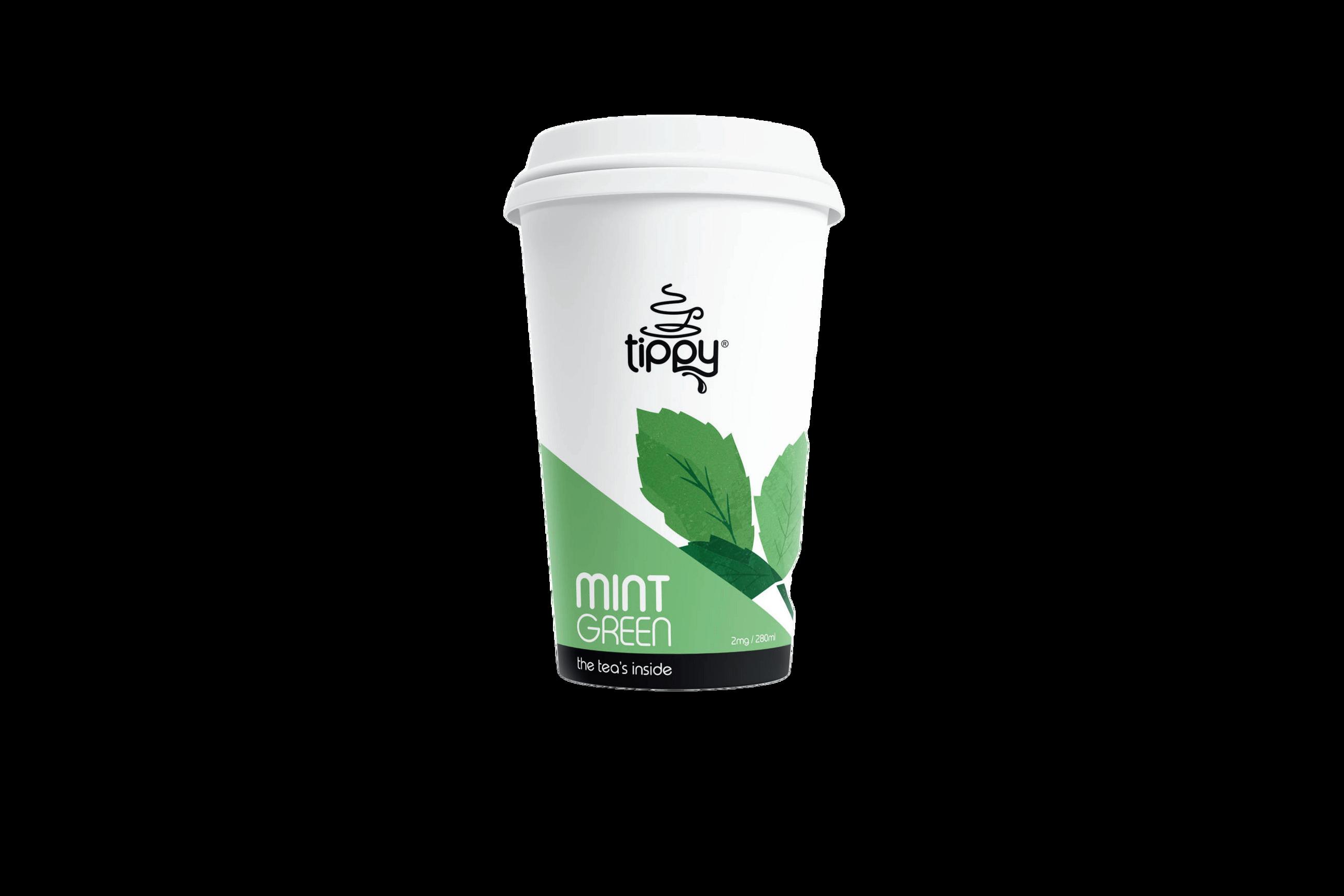

in a simple on-the-go format.”.
Many traditional tea bags contain plastic, which is used to heat seal the filter bag, preventing it from falling apart. This plastic is usually inside the paper filter bags and in the glue used to heat seal the bags, mainly polypropylene.
The Tippy Tea Cups have been made from 100 percent compostable paper and a plant-based filter and lining. The cup lids have been made of 100 percent natural sugarcane. The design is straightforward to use; simply add water and enjoy.
If customers wish to change the strength of the brew, they can fill one-fourth of the cup with hot water, swirl it gently to strengthen the brew, and then top it up with more hot water.


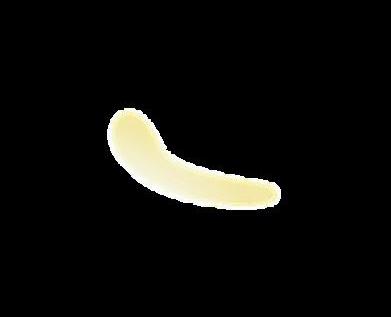


Available in five tea flavours, including English Breakfast, Earl Grey, Lemon Ginger, Mint Green, and Jasmin Green, all made from 100 percent natural ingredients. n just add hot water & enjoy the tea.
Instant brewing cup of premium tea
U p to 3 refills

All natural premium quality ingredients sit in the base of the cup

Double-walled heat insulation
Food-grade fibre filter + compostable cardboard



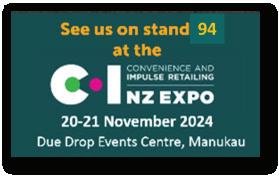


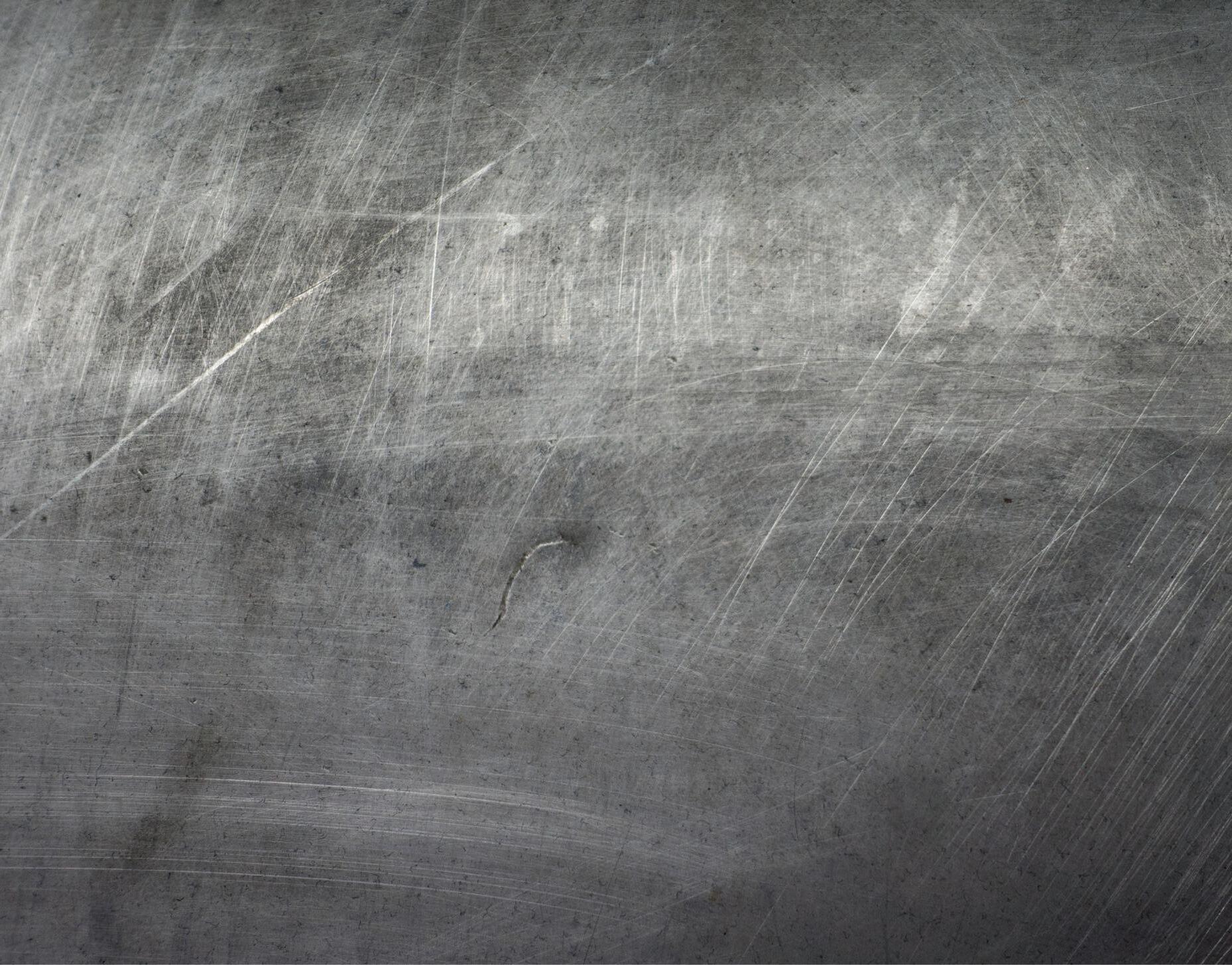

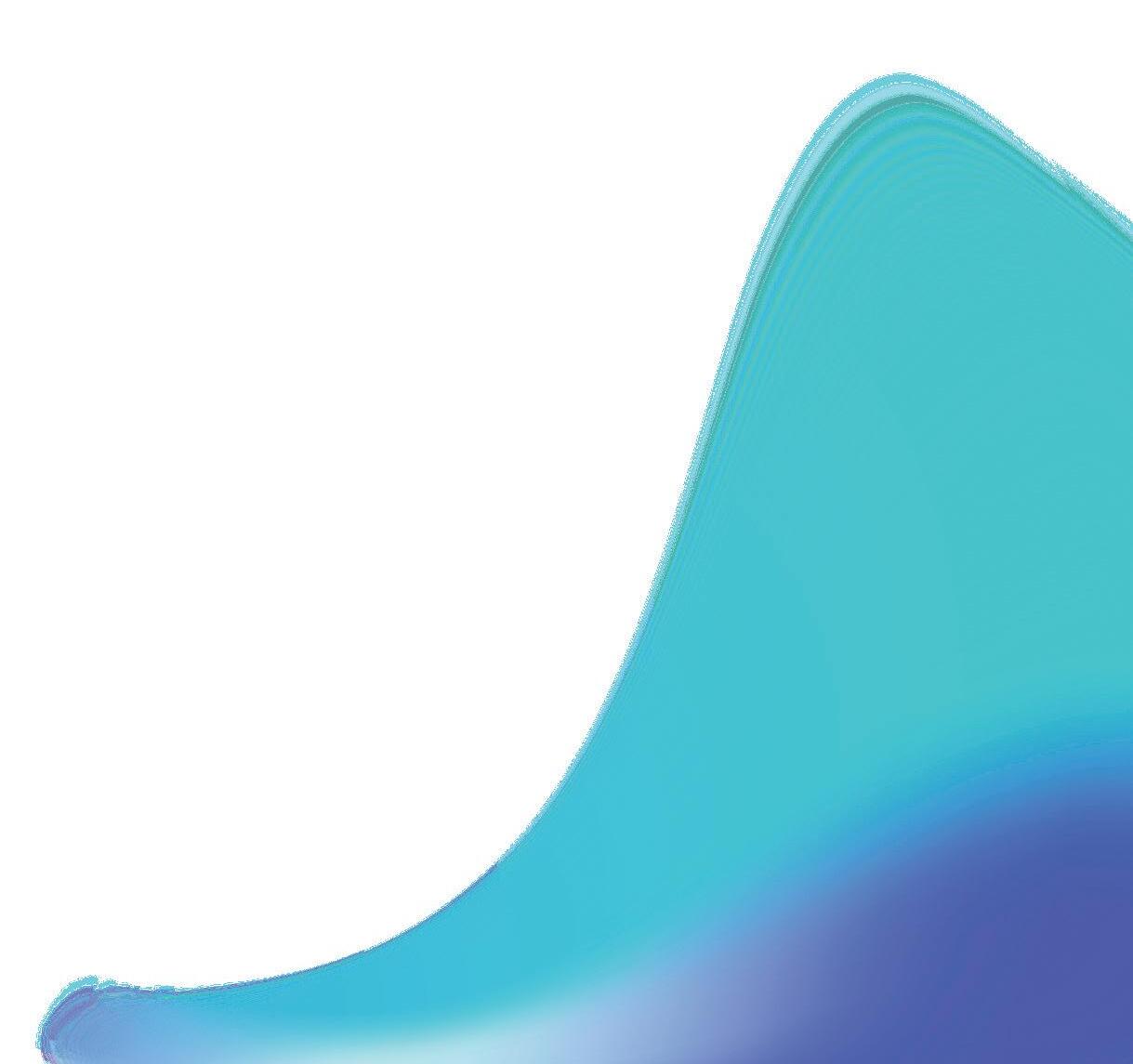

Our vision is to provide healthy, convenient and delicious food to the community! From classic kiwi coleslaw, pasta and potato salad, to crafted salad bowls and scrumptious yoghurt granola pots, you're sure to find something delicious to suit a variety of customers. Find us at Stand 16 at the C&I Expo in November and discuss your needs with our expert team, or give us a call today!
Our vision is to pro hy, convenient and delicious food to th ty! From classic kiwi coleslaw, pasta and potato salad, to crafted salad bowls and scrumptious yoghurt granola pots, you’re sure to find something delicious to suit a variety of customers. Find us at Stand 16 at the C & I Expo in November and discuss your needs with our expert team, or order from Gilmours today! www.freshtogo.co.nz 09 525 7294
www.freshtogo.co.nz 09 525 9808



Kiwi coffee brand Zephyr Coffee Co. has partnered with Kākano Youth Arts Collective for their newest artist collaboration, featuring on their coffee bags, in-store point of sale and merchandise.
The Kākano initiative was developed by independent artist Mandy Patmore following a pilot programme established in 2013, recognising the needs of some of West Auckland’s most vulnerable young people, all of whom had struggled with mainstream education.
Since then, it has grown into a hugely successful initiative and has changed the lives of many young people.
Continuing in her role as Creative Director, Patmore has been supported by a team of art tutors and youth support workers, enabling Kākano to run three sessions a week for the rangatahi, working closely with Oranga Tamariki, NZ Police, alternative education providers, youth services and local government.
Under the guidance of these highly experienced tutors, all practising multidisciplinary artists, the rangatahi can develop their art practice, increase their confidence and strengthen their self-worth.
Alongside the studio sessions, Kākano has a strong presence in the wider community, creating murals and artworks for public spaces, allowing the group to develop real, tangible skills that can be applied to multiple pathways in the future.
“We are proud to support this unique and special programme and have been working with their young artists to create a series of designs to showcase over the next 18 months,” said Zephyr.

“Our first feature artist, 19-year-old Georgia has been a member of Kākano for five years, and it has been incredible watching her design develop and evolve. Her interpretation draws from the journey of our coffee and the distinct personality of the Zephyr brand. Her approach combines a detailed depiction of a native Kōtare bird with an abstract background.”
She said that the background colours had been chosen to reflect the shades of a coffee cherry, and the Kōtare was inspired by the definition of Zephyr as a gentle breeze, capturing a sense of freedom, courage, and adventure.
The new artwork will be visible across all Zephyr partner outlets. A complete list of Zephyr partner cafes can be found on the website at http://www.zephyrcoffee.co.nz/ stockists. n

by



VITHIT is a unique blend of water, juice, tea, and vitamins, making it the ultimate health drink. With less than 35 calories per bottle and ten exotic flavours, VITHIT is the perfect alternative to sugary, calorie-filled drinks.
Four new flavours from VITHIT include Perform, Boost, Lean & Green and Immunitea.
Perform is a tropical blend of mango and passionfruit juice with essential amino acids, while the Lean & Green is a mouthwatering blend of apple and elderflower

for a fresh, crisp taste combined with an antioxidant hit of Maté Tea.
Boost is a delicious blend of summer berries fused with water and a powerful burst of ginseng and rooibos tea. At the same time, Immunitea is a delicious juice blend of dragonfruit and yuzu combined with health-boosting Ceylon tea. VITHIT was created because of a lack of healthy drinks in fridges today.
For more information visit www.realfoods.co.nz
For the Cartel Food Company, it has always been about creating great tasting, quality frozen Mexican-inspired products. We believe it is not hard to create good frozen food if you use good ingredients and apply some care.
Consumers confirm that belief when they regularly tell us, “Wow, that actually tastes good.” We think that comment comes from a perception that frozen convenience food lacks taste and quality. Try our range of frozen burritos, with five tasty flavours to choose from and a three-minute freezer-to-plate cook time.
Each burrito is loaded with flavour because our meat and poultry are braised in ingredients like chipotle, jalapeño, lime juice, pinto beans and our secret spices.
They are an ideal option for busy families, students, professionals or anyone needing a quick tasty fix on the move. n
To become a stockist, contact Louise Sheehan orders@cartelfood.com or 021 150 7389.
Since 1968, the iconic blue and red giraffe image has appeared on the side of the cups used by dairies, ice cream parlours, cafes and takeaways for milkshakes and thickshakes. Nearly every Kiwi will have had a shake in one of these cups and the sight of one will bring back memories of walking home from the local pool on a hot summer’s day, Friday fish and chips wrapped in paper or holidaying at the beach with family. Each memory triggered by the thought of slurping down a cold shake.
Today The Longest Drink In Town remains New Zealand’s favourite milkshake and Kiwis of all ages still love popping down to the local shop and getting a cold shake with their own favourite flavour. These flavours have been made for the last ten years by Delmaine Fine Foods, one of New Zealand’s leading food manufacturers, through high quality milkshake syrups under the Longest Drink in Town brand.
This summer make sure you take advantage of the country’s love for milkshakes and the brand that brings back so many memories, by having a good supply of The Longest Drink In Town cups and syrups. n
Contact Delmaine Fine Foods on 0800 335 624 or speak with your local representative.







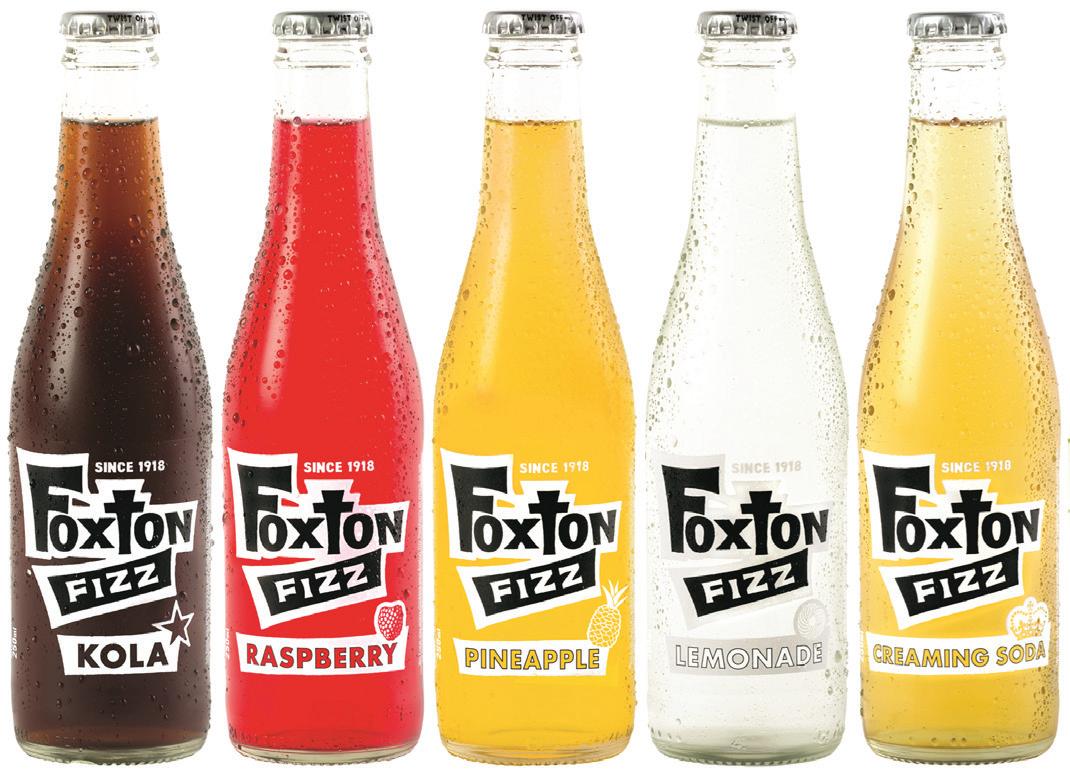
oxton Fizz has been increasing distribution in the last 12 months, adding to the 104 year old brands’ footprint in the grocery and convenience channels. In addition to increased distribution, they’ve been working on their NPD and have recently re-introduced Foxton Fizz Pineapple in the 250ml bottle. Pineapple is an old favourite, last bottled around 2004, meaning the 20 year hiatus is over. The new Pineapple flavour is not the only new retail product – the Foxton Fizz Sampler Pack, consisting of 2 bottles of each of the 6 flavours, is now
available as a retail pack and is proving to be very popular as a take home pack or gift. The small town soda brands, of which there used to be over 200, were strongly associated with family gatherings and holidays such as Christmas and Easter, and it seems this continues. n
Foxton Fizz is supplied o the grocery channel by DKSH New Zealand.
Phone +64 6 356 5323
Email customerservice.nz@dksh.com




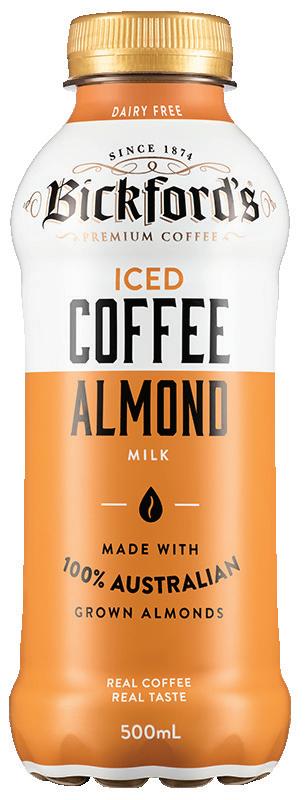
Attention Service Station & Convenience Store Owners! Need an alternative option for your customers craving a coffee or chocolate hit without the dairy? Bickford’s has been crafting irresistible beverages for over 100 years. Made with 100% Australian almonds, our RTD range offers a smooth, creamy texture and a bold hit of coffee or chocolate.
• Dairy-free
• Vegan-friendly
• Gluten-free
• GMO-free
• Free from artificial colours and flavours
Available in two delicious flavours: Iced Coffee Almond and Iced Chocolate Almond. Give your customers a delicious, dairy-free alternative! Available through selected Mobil and On The Spot stores nationally.
Contact chris.bhimy@bickfordsgroup.com to order now.

MOST Juice is celebrating 10 years of delivering organic juiciness in every drop to New Zealanders. Crafted with love from New Zealand apples, MOST stands out with its BioGro New Zealand organic certification, offering both still and sparkling options. With no added sugar, preservatives, and artificial flavours or colours, MOST delivers a refreshingly pure taste that reflects our commitment to organic excellence. For MOST, the phrase ‘you only get out what you put in’ rings true. Every bottle of MOST Juice embodies their dedication to simple, high-quality ingredients and their unwavering belief in the best intentions. Here’s to another 10 years of bringing the pure taste of certified organic juice to your glass!
For more information, contact your local Coca-Cola Europacific Partners New Zealand representative or call 0800 505 123






Display your products in style with Airex’s sleek, energy-efficient merchandisers and refrigerated back bars.
In today’s competitive market, the way you present your products can make all the difference. Airex has reimagined the art of merchandising with its new-look Merchandisers and Refrigerated Back Bars, designed to showcase your offerings in a sleek, efficient, and eco-friendly way. Here’s why Airex should be your go-to choice for maximising sales.
Presentation is key, and Airex Merchandisers deliver just that. Available in Single, Double, and Triple Door options, these upright units are perfect for cold drinks and food, providing an irresistible, ready-to-serve display in any front-of-house setting. Their sleek design ensures that your products are always the star of the show.
Whether you’re working with the AXR. MEUR.1D, AXR.MEUR.2D, or AXR. MEUR.3D series, Airex Merchandisers are built for one thing: exceptional visibility. With frameless, ultra-clear, Low-E double glazed Argon-filled glass doors, energyefficient LED lighting, and adjustable temperature controls, these merchandisers ensure that your products look their best, while keeping condensation at bay.
Customers can’t help but be drawn to the brilliant display!
Environmentally Friendly, Energy Efficient
Sustainability is at the forefront of Airex designs. Each merchandiser is equipped with eco-conscious R290 Hydrocarbon refrigerant and cyclopentane polyurethane insulation, reducing energy consumption while maintaining optimal cooling. Not only do you get a high-performance unit, but you also contribute to a greener planet.
Maintaining a clean, professional display has never been easier. Airex Merchandisers feature a smudge-free electrostatic finish, which resists fingerprints and marks. This means your display stays spotless, keeping your brand image sharp and always appealing.
Airex Merchandisers are designed with the user in mind. With adjustable shelves, self-closing doors, castor wheels, and adjustable leveling feet, these units provide flexibility for various setups. The standard product guides and ticket stripping make organizing your display a breeze. For businesses with space constraints, the Slimline and Countertop units offer compact solutions without sacrificing display quality.
For bars and restaurants, the Airex Refrigerated Back Bars provide the perfect balance of style, function, and efficiency. Available in 2-door and 3-door configurations, these units feature rearmounted refrigeration to save space, while the double-glazed heated glass doors and energy-efficient vertical LED lighting enhance product visibility and reduce condensation.
With an adjustable digital temperature controller and fan-forced airflow, you can ensure that your drinks are always kept at the ideal temperature. The modern black internal finish (excluding the base) adds a sleek aesthetic, creating a sophisticated back bar that enhances the overall ambiance of your establishment.
From Merchandisers to Refrigerated Back Bars, Airex delivers stylish, energy-efficient, and environmentally friendly solutions that elevate your product displays and drive sales. With features that prioritise ease of use, sleek presentation, and energy conservation, Airex ensures that your business stands out in every possible way.
Make the switch to Airex today and watch your products shine like never before! n
For more information visit www.stoddart.co.nz



Associate Energy Minister Shane Jones said New Zealand’s fuel resilience is being strengthened to ensure people and goods keep moving and connected to the world in case of disruptions.
Fuel security has been a priority for the Coalition Government, who were acutely aware of how essential engine fuels were to the New Zealand economy and how a fuel disruption would impact New Zealanders.
New Zealand imports nearly all its engine fuels, making it particularly vulnerable to international and domestic supply disruptions. Ensuring enough reserve stocks have been held in the right place would help reduce possible disruptions and is a crucial pillar of fuel security.
“The previous government introduced a minimum stockholding obligation, which means from the 1st of January 2025, fuel importers will be required to hold 28 days’ cover for petrol, 24 days for jet fuel and 21 days for diesel,” said Jones.
“Importantly, the minimum stockholding obligation regulations introduce a new information disclosure rule which gives the government a clearer oversight over how much fuel is held in New Zealand.”
However, Jones was not satisfied that 21 days’ cover for diesel was enough or that the jet fuel stockholding rule was sufficient to avoid disruptions to international aviation such as those experienced in 2017.
He said that diesel was the most essential fuel as it kept food and people moving through our country. Without it, New Zealanders would struggle to access everything they need.
“We need to hold enough diesel onshore to keep essential goods moving through the country and vital services running, even if fuel supply chains have been disrupted. For this reason, I am seeking feedback on increasing diesel reserves to 28 days’ stock to help reduce any potential impact of a disruption to supply.”
Jones was also concerned about the
ALONG WITH REVERSING THE BAN ON OIL AND GAS EXPLORATION, THESE ACTIONS WILL FURTHER STRENGTHEN NEW ZEALAND'S RESILIENCE,
security of the jet fuel supply at Auckland Airport. In September, he informed the fuel companies that own the airport's jet fuel infrastructure of his plan to seek Cabinet agreement on regulations that would mandate sufficient jet fuel to be held near Auckland Airport.
Auckland Airport has been New Zealand’s gateway to the world. Seventy-five per cent of all international seat capacity goes into New Zealand, and 90 per cent of all longhaul flights come into Auckland.
New Zealand learned the hard way in 2017 when the jet fuel supply was disrupted, forcing planes to be diverted and reducing the country’s connection with the world. Further issues with jet fuel quality in 2022 reinforced the need for action.
“Despite the 2019 government inquiry into the 2017 Auckland Fuel Supply
Disruption recommending that jet fuel companies urgently increase their jet fuel holdings near Auckland airport, little progress has been made.”
He added that establishing a locationspecific jet fuel stockholding requirement would ensure the jet fuel companies acted to ensure enough fuel was on hand to ride out any disruption to supply.
“Along with reversing the ban on oil and gas exploration, these actions will further strengthen New Zealand’s resilience and self-determination to ensure disruptions to our energy supply do not halt the economy.”
The Government has sought public feedback on options for increasing New Zealand’s diesel reserves. The consultation will close on the 6th of December. n

Chargefox has announced the full integration of its charging services with new Mercedes Benz electric vehicles through Mercedes Me Charge.
This innovation has marked an Australian first. It has enabled Mercedes EV drivers to find, charge, and pay for charging services directly through the Mercedes Me app and their vehicle's infotainment system.
Drivers of select Mercedes Benz electric vehicles now have seamless access to over 2,700 charging plugs nationwide.
“This integration with Mercedes demonstrates how finding, using and paying for charging can be ‘baked-in’ to the vehicle so that car makers can own and optimise the experience, and drivers don’t need a separate app or device,” said Craig Norris, Head of Channel Partnerships at Chargefox.
Mercedes Benz has been a critical player in the Australian EV market for years, offering free Chargefox charging subscriptions with several models. The extensive number of public chargers available on Chargefox across
every state and territory has given EV owners the confidence to travel long distances.
This latest integration has taken convenience to the next level, allowing drivers to find, navigate, use, and pay at their nearest charging station directly from their car or via the Mercedes-Me app.
"This is a world first. This is the first time anywhere that Mercedes drivers can use their charging subscription to pay for charging directly from their vehicle or Mercedes app,” said Nick Wodzinski, Head of Product at Chargefox.
Chargefox has become the exclusive provider of this service to Mercedes in Australia. It has joined over 1,300 providers offering over 1.5 million charging points to Mercedes drivers globally through Mercedes me Charge.
Chargefox has remained dedicated to revolutionising EV charging in Australia, making it simple, affordable, and accessible. Its commitment to innovation and the vast charging station network drive the transition to clean transportation. n
Independent Dutch retailer Paul Toepoel opened the new SPAR Supermarket in Diemen Zuid.
Located at Holland Park in Diemen Zuid, a residential area with many families and urban professionals, this has been an evolving area of a longstanding district.
Paul Toepoel, the independent retailer of the SPAR Supermarket Diemen Zuid, previously managed the store in Warmoesstraat, in the centre of Amsterdam.
This entrepreneurship underpinned the spirit of the SPAR brand and the importance of independent retailing as part of the SPAR retail network. The new store team is comprised of experienced employees from a store that had been closing and recruiting.
In-store, the offering has been tailored to the convenience for which SPAR Netherlands is known, including installing a SPAR FoodClub. Customers can get freshly made salads, sandwiches, pasta,
pizzas, Tosti Club sandwiches, barista coffee, and in-store bakery.
Residents of the nearby area can also source daily grocery essentials. This includes a selection of fresh fruit and vegetables and food items ranging from cooking ingredients to snacks and drinks to frozen products. A range of household and personal care items are also available.
Digital innovations integrated during the store fit-out include media screens at several strategic locations, while self-checkouts streamline the shopping experience. The overall ambience has aimed to provide customers with a pleasant and convenient shopping experience.
The Dutch wholesaler Adriaan van Well founded the SPAR brand in the Netherlands in 1932. It was established as a voluntary chain of grocers under the name DESPAR –an acronym of a slogan created by van Well to describe the organisation: Door Eendrachtig Samenwerken Profiteren Allen Regelmatig. n






• Comprehensive logistics solutions for Volkswagen Slovakia extended until 2029
• DHL strengthens its role as key logistics partner in automotive manufacturing
Bratislava, September 30, 2024:
DHL Supply Chain, the world's leading provider of contract logistics services, is pleased to announce the extension of its longstanding partnership with Volkswagen Slovakia. The collaboration, which began in 2010, was contractually agreed for the next five years after a successful selection process. DHL Supply Chain's thus strengthens its position as a key logistics partner to the automotive industry. Under the new agreement, DHL Supply Chain Slovakia will continue to provide
intra-company logistics services for the Volkswagen Slovakia plant in Bratislava, including supplying production lines at the plant. Leveraging extensive experience in automotive logistics, DHL Supply Chain will support the production facility in maintaining the highest production standards.
The Volkswagen Slovakia plant in Bratislava, spanning an area of more than two square kilometers, produces eight models under four different Volkswagen Group brands. DHL Supply Chain provides comprehensive internal logistics solutions for the plant, including freight management, receipt of production materials and material handling, packaging management, and the delivery of components at the right time and in the right quantity based on individual production cycle cadence. With over 2,400 employees on site, DHL’s logistics experts ensure a smooth process, making an important contribution to production efficiency.
"The extension of our partnership is confirmation of the reliability and quality of the services we provide," says Peter Benda, Business Unit Director at DHL Supply Chain Slovakia. "Our role is to understand the needs and requirements of our partner and work together to develop optimal logistics solutions and innovations, which include automation and digitalization. We are delighted to continue supporting Volkswagen Slovakia with our expertise in intra-company logistics and look forward to further successful collaboration."
"In these extremely challenging times, when we face global supply chain shortages, having a reliable and flexible logistics partner is more important than ever. I believe that together we will be able to overcome all current and future challenges," says Juraj Mráz, Head of Logistics at Volkswagen Slovakia.
The partnership in Slovakia is just one part of a broader cooperation between DHL Supply Chain and Volkswagen in various markets, making DHL Supply Chain one of the key logistics partners to the automotive industry. n
Waitrose has partnered with Just Eat, the UK’s biggest delivery network, on a multi-year deal to expand its presence in the on-demand grocery and convenience sectors.
Millions of Just Eat customers in the coming weeks can order their favourite food and drink delivered in 30 minutes or less from 229 Waitrose locations across the UK. The partnership went live this week in Birmingham, Glasgow, London, and Manchester.
Waitrose's average weekly on-demand grocery sales increased by 140 percent in the first six months of the year, helping the retailer reach a broader range of customers.
More than one million Brits regularly get their groceries delivered by Just Eat, with the platform delivering 12 grocery orders to UK customers’ doors every minute last year alone.
“Partnering with Just Eat and stepping up our plans for new shops allows us to reach even more customers who want the same commitment to quality, taste and ethical standards whenever and wherever they want
to enjoy great food,” said Waitrose Executive Director James Bailey.
“As demand for greater convenience has grown, so have expectations of convenience food - which is a huge opportunity for us.”
Just Eat customers can order from thousands of items, including the revamped premium range Waitrose No. 1 and Essential Waitrose.
In addition, Waitrose Duchy Organic, fresh ready meals, free-from and vegan ranges, British brands like Gail’s Bakery and Deliciously Ella, plus award-winning wines, beers and spirits, will all be available. Later this year, customers can choose from more than 550 Waitrose Christmas products, including 175 new festive treats for 2024.
Waitrose recently confirmed plans to open up to 100 convenience shops across the UK in the next five years. This will add to the more than 90 Shell forecourt shops it supplies and a franchise agreement for shops in 27 Welcome Break motorway service areas.
“Many of today’s consumers no longer consider speed a luxury but a necessity. This is supported by Just Eats’ research - three in

four people who have ordered on-demand groceries believe it will become a part of their daily lives,” said Claire Pointon, Managing Director for the UK and Ireland at Just Eat.
“Just Eat is proud to be leading this change, and so we’re thrilled to be adding Waitrose to our list of grocery partners, strengthening the choice and value available for customers on the platform - whenever and wherever they need us.”
The news followed Just Eat’s recent exciting partnership announcements in the UK and globally, including Boots, Cardfactory, Lovehoney and HelloFresh, demonstrating consumer appetite for convenience for various products and moments. n
FamilyMart Co., Ltd. has focused on expanding the sales floor space of its stores by opening satellite stores, such as unmanned payment stores, to meet the diversifying needs of its customers.
As part of this effort, FamilyMart will gradually convert the eat-in areas installed in stores into sales floors and, in the future, will proceed with converting them into sales floors that handle products and service-related materials, leading to improved convenience through an expanded product lineup.
The FamilyMart convenience store business has been installing eat-in areas since 2013 to create comfortable store spaces. Approximately 7,000 stores currently have eat-in areas.
However, since the outbreak of COVID-19, the ways in which customers have used convenience stores have diversified, and the business has also seen changes in the use of eat-in areas.
The business has promoted the creation of eat-in sales areas to effectively use in-store space, improve customer convenience, and provide a wide range of products to meet

diversifying needs.
It will strive to make the store even more useful for everyday shopping by expanding its product lineup. It will also focus on clothing such as "convenience wear," for which demand has grown, as well as daily necessities
such as toilet paper and detergent. Going forward, FamilyMart will continue to verify the program's effectiveness at participating stores and make appropriate changes to the eat-in sales area to create sales areas suitable for each store. n




Nestlé Purina PetCare, in collaboration with The Kenan Advantage Group, Inc. (KAG) and Nikola Corporation, launched its first zero-tailpipe-emission delivery using a hydrogen fuel cell electric semi-truck.
On its inaugural journey, the truck transported Purina products, including Tidy Cats cat litter, between three California cities: Stockton, Maricopa, and Modesto. This represented a small part of Purina's overall strategy to reduce greenhouse gas emissions.
"We are continuously identifying new opportunities within our business and through partnerships to help us meet our sustainability goals," said Travis Krous, Purina's senior director of Supply Chain Operations.
"This truck represents an exciting opportunity to test new technology and determine if it's feasible to scale."
Purina's manufacturing strategy has
promoted regional production and distribution, minimising the number of long-distance trucks on the road. KAG will deliver Purina products using the Class 8 Nikola hydrogen fuel cell electric semitruck, which has a maximum range of up to 500 miles and can be refuelled in 20 minutes or less.
All while producing zero tailpipe emissions while driving; according to Nikola, one truck avoids 97 metric tons of CO2 tailpipe emissions per year on average, the equivalent of taking 23 passenger vehicles off the road for a year.
"We're excited to transport products on our first hydrogen fuel cell truck while helping our valued customer and partner, Purina, drive its sustainability goals forward," said Tyler Coventry, executive vice president of KAG Food Products.
"We're committed to implementing more sustainable practices within the supply chain by optimising energy-efficient technologies."
"We are proud to support Purina's sustainability initiatives by supplying KAG with its first-ever hydrogen fuel cell electric Class 8 truck," said Nikola president and CEO Steve Girsky.
"This collaboration aligns with our mission to drive innovation and environmental responsibility in the transportation industry."
At its Tidy Cats-producing factory in Maricopa, Purina has implemented solar drying technology for the clay used in scooping and non-scooping litter. This innovative solution has led to substantial reductions in energy needs.
Purina has also been reducing its use of virgin plastics globally. Key to this effort was incorporating recycled content into packaging. By the end of the year, all Tidy Cats litter jugs will be made with 100 percent recycled content. Specially designed pail refill bags also help reduce plastic waste and allow cat owners to reuse pails. n

At some point, an energy crisis is inevitable – it’s not a question of if, but when. As recent global geopolitical tensions, cyberattacks, pandemics, and supply chain disruptions have demonstrated, energy security is a pressing matter of national sovereignty.
A key component of energy security is storage. While technologies, like pumped hydro and batteries have dominated discussions and are essential solutions to energy security in their own right, they are not the only energy sources that need to be stored.
For example, the International Energy Agency (IEA) must stockpile 90 days’ worth of oil imports, which can be difficult if supply chains are disrupted. Maintaining these levels is a large and growing concern.
For this reason, we as a nation should look to a national transformation and transition to e-methanol. This would reduce the need for oil imports and enable the stockpiling of a sustainable alternative. Additionally, this shift would be subsidised through optimising the electricity market.
What is e-Methanol?
Methanol, often called wood alcohol, is conventionally derived from fossil fuels. It can also be made from hydrogen and biomass. It is a flammable liquid that can be stored easily at normal temperature and pressure. It already has a strong market presence as a fuel and a precursor to many chemicals and has even been used in fuel cells to generate electricity.
There are some issues with methanol as an energy source: for example, converting electricity to methanol and back is often criticised for energy losses. However, this issue can be mitigated entirely through e-methanol, which is methanol generated from renewable sources and then optimised as part of a broader ecosystem like Sunshine Hydro’s Superhybrid system.
This Superhybrid system combines longduration energy storage, like pumped hydro, with flexible loads, such as e-methanol production. E-methanol is produced and stored, allowing the system to sell it as a fuel or ramp up electricity production when the market demands it.
A significant advantage of this approach is that it has no technical upper limit. It’s modular and can be expanded by adding more tanks, offering scalability that
traditional energy storage systems struggle to match. Superhybrid systems are versatile, allowing short-term energy market flexibility and long-term seasonal energy storage.
What does this mean for fuel security?
Beyond electricity storage, e-methanol is attractive to national sovereignty because it can also serve as a national fuel reserve.
Methanol-powered trucks are already available from manufacturers like Geely (China) and AsokLeyland (India), making the transition to methanolpowered vehicles more achievable than other alternatives. These trucks run on internal combustion engines, providing an easy way to begin decarbonising transport.
Methanol is also gaining ground in the marine sector. Around ten percent of new ships contracted can run on methanol, and smaller vessels like tugs already use methanol engines and fuel cells.


As methanol logistics expands, its use in sectors like agriculture, construction, and mining, critical areas of national security, will only increase. Another compelling reason to move to ethanol is that ultra-deep e-methanol storage is incredibly costeffective compared to traditional energy storage options.
A substantial pumped hydro project typically offers around 24 hours of storage at a capital cost of around $300 per kWh. Similarly, vanadium flow batteries cost about $700 per kWh for a 12-hour system. In contrast, scaling an e-methanol plant to include a three-month ultra-deep storage capability would make the cost per kWh system as low as $0.32 – hundreds of times cheaper than pumped hydro or battery solutions. With the ability to store energy for months, e-methanol offers a superior solution for long-term energy storage.
Overall, the energy sector must start thinking creatively to ensure energy resilience and decarbonisation. E-methanol storage presents a unique opportunity to provide long-term energy security while offering flexibility in the fuel market.
Other synthetic fuels, like Sustainable Aviation Fuel (SAF), could play a role, but of all the solutions, e-methanol should be seen as the most attractive given its scalability and economic viability. By incentivising and embracing innovative solutions like e-methanol, the nation can secure a greener, more resilient future. n
Column by Sunshine Hydro





GlobalData reveals that the demand for packaged baby food has grown in APAC with the rising female workforce.
The increasing participation of women in the workforce across the Asia-Pacific (APAC) region, coupled with the hectic work schedules of dual-income households, has reshaped consumer behaviour towards packaged baby food.
GlobalData revealed that rising per capita incomes and the need for convenience have driven more significant demand for baby formula, ready-to-eat finger foods, and other baby care products in key APAC markets.
“Most countries in the APAC region have witnessed a steady increase in the female labour force during the past few years,” said Mohammed Masiuddin Shajie, Lead Consumer Analyst at GlobalData.
“The baby food sector in South Korea,
Japan, Singapore, and Malaysia is expected to grow at a higher compound annual growth rate (CAGR) than the regional average during 2023-28.”
According to the World Bank, the female labour force as a percentage of the total labour force grew from 42.1 percent in 2018 to 43.5 percent in 2023 in South Korea. In Japan, it grew from 44.1 percent in 2018 to 45.1 percent in 2023.
Countries such as Singapore and Malaysia also witnessed an increase in the female labour force during the last five years.
“Busy lifestyle is compelling parents to shift towards convenient baby food options such as baby formula milk and ready-toeat finger food/drinks. Rising per capita income in these Asian economies supports this consumer shift,” said Deepak Nautiyal, Consumer and Retail Commercial Director, APAC and ME at GlobalData.
According to GlobalData 2024 Q2 consumer survey, 13 percent of respondents reported switching to cheaper alternatives within the same brand. Meanwhile, 18 percent indicated they had opted for other, more affordable brands to reduce spending on baby care and childcare products.
Additionally, 13 percent mentioned turned to store-brand products to save money on these items.
The increasing participation of women in the workforce, coupled with the growing demand for convenient baby food options, presents a substantial growth opportunity for the baby food industry in APAC.
However, to remain competitive amidst economic pressures, manufacturers must adapt to changing consumer preferences by offering value-driven products that cater to evolving price sensitivities. n
Bp charge is expanding its national network of fast EV chargers with new charging hubs at bp Connect Tirau and bp Connect Wanaka, supported by EECA (the Energy Efficiency and Conservation Authority).
The new sites provide Kiwi EV drivers with convenient access to 150kw fast charging with six charge points at bp Connect Wanaka and ten charge points at bp Connect Tirau.
These two new charging hubs are funded by bp and EECA, with co-funding from EECA’s Low Emission Transport Fund (LETF). They join bp charge’s already operational hubs in Auckland at bp Connect Hobsonville, bp Connect Rosedale and bp Connect Smales Farm.
Haley Mahoney, Head of Country, bp New Zealand, said the new EV hubs in Tirau and
Wanaka are milestones for bp charge.
“bp charge is on a journey to create New Zealand’s most convenient EV fast-charging network.
“bp Connect Wanaka is our first hub site with EV charging in Central Otago and bp Connect Tirau has a drive-through suitable for larger vehicles, making charging on-thego a breeze.
“We’re supporting Kiwis no matter their choice of mobility, with fast EV chargers at convenient locations that offer our great wildbean cafe coffee, food and a comfortable place to take a break from a drive.”
With EECA’s support, bp charge is adding additional EV hubs at seven more bp locations in 2025 in Auckland, Bay of Plenty, Manawatu and Otago. Richard Briggs, EECA’s group manager –delivery and partnerships, said partnering
with companies like bp on public EV infrastructure projects generates insights that benefit the wider sector.
“EECA is able to learn from bp’s technical expertise that comes from their international experience and support other businesses to overcome the barriers they face. This is helping to accelerate the rollout of New Zealand’s public EV charging network," he said.
bp is committed to powering the electrification of transport and identified New Zealand as a growth region for its EV charging business.
Since beginning operations in late 2022, bp charge has installed fast EV chargers at more than 60 locations across New Zealand’s North and South Islands and plans to install the country’s first EV Gigahub™ in Christchurch later this year. n





Genesis Energy will acquire a majority shareholding in ChargeNet, New Zealand's largest nationwide electric vehicle (EV) public charging network. This strategic move has positioned Genesis as a key investor in the growth of the country’s EV market and the energy transition.
Under the agreement, Genesis will acquire a 65 percent stake in ChargeNet for $64 million, including a significant investment in the business to fund its near-term growth. This investment gave Genesis a faster pathway to a new value pool identified within the company’s Gen35 strategy.
Established in 2015, ChargeNet has operated more than 400 public fastcharging points nationwide. Over 90 percent of New Zealand’s EV owners are registered as customers.
With a substantial development pipeline, ChargeNet is poised to drive further growth as New Zealand's shift toward sustainable transport gains momentum.
Genesis’ investment will enable ChargeNet to accelerate that growth, with charge points expected to double by 2030. This also supported the government’s goal of having a national network of 10,000 chargers by 2030.
Chief Retail Officer Stephen EnglandHall emphasised the deal's importance in progressing Genesis’ strategy of supporting customers to electrify their lives and achieve
a 30 percent market share in EV customers by FY28. The investment will support the country’s net zero 2050 goal while delivering customer value.
“Decarbonising transport is crucial for New Zealand's future, and public charging infrastructure is a key element of that transition. This partnership combines ChargeNet’s market leadership with Genesis’ energy expertise and customer reach, enabling us to play a leading role in shaping the future of transport in New Zealand,” said England-Hall.
“With nearly 500,000 customers, Genesis can accelerate ChargeNet’s market leadership by utilising our energy management expertise, guiding larger customers through fleet transitions and ensuring we deliver the best charging network for the country’s EV drivers."
He saw strong potential in the New Zealand EV market. He said that rapid charging infrastructure was crucial for this transition, and Genesis’ investment would accelerate a faster nationwide rollout, increase customer access and drive value for shareholders.
Even with road user charges and a mix of at-home and public charging, running an EV was still more cost-effective than driving an ICE car.
Genesis has committed to a $1.1 billion investment in renewable electricity infrastructure. This includes the recent
$150 million investment in a 100 MW/200 MWh grid-scale battery at Huntly Power Station and the delivery of up to 500 MW of grid-scale solar by FY28.
ChargeNet CEO Danusia Wypych said the partnership with Genesis would accelerate network expansion and scale operations, benefiting all consumers.
“Since our inception, we have been committed to reducing New Zealand’s reliance on fossil fuels in transport. We are proud of what we have achieved and excited about what lies ahead,” said Wypych.
“With Genesis as a strategic partner, we intend to double the pace of installations and develop new solutions to ensure faster, more reliable charging experiences for all customers.”
New Zealand is still in the early adoption phase with EVs, which account for around four percent of the country’s light passenger vehicle fleet. This is expected to increase to more than 25 percent within the next eight years.
By expanding the country’s charging infrastructure and integrating advanced energy solutions, Genesis and ChargeNet aim to make EV adoption more accessible and convenient for all New Zealanders.
The investment in associates falls outside Genesis’ FY25 capital expenditure guidance. However, the FY25 EBITDAF guidance has remained unchanged at $460 million. n


Hyundai Motor Group (the Group) has signed a collaborative research agreement with Nanyang Technological University, Singapore (NTU), in the field of new energy. The partnership will encompass a three-year research collaboration focusing on hydrogen energy business and advanced energy systems.
This collaboration between the Group and NTU, a globally renowned university, aims to bring Singapore closer to achieving carbon neutrality. The partnership will focus on developing alternative energy sources that leverage the Group's advanced energy technologies and suit Singapore's unique characteristics.
“HMGICS is a global hub for Hyundai Motor Group’s future mobility innovation,” said Hyun Sung Park, Vice President and CEO of Hyundai Motor Group Innovation Center Singapore (HMGICS).
“Through this partnership, we aim to accelerate our research in innovative technologies, ultimately enhancing the commercial viability of our sustainable mobility solutions.”
The signing ceremony, which took place at the Singapore-Korea Business Forum, Ritz Carlton Singapore this month, was attended by Jaehoon Chang, President and CEO of Hyundai Motor Company; YoungJoon Yoon, President and CEO of Hyundai Engineering & Construction (Hyundai E&C); Hyun Sung Park, Vice President and CEO of HMGICS; Professor Lam Khin Yong, Vice President (Industry) of NTU;
Professor Madhavi Srinivasan, Executive Director of Energy Research Institute at NTU; Duk-Geun Ahn, Minister of Trade, Industry and Energy of the Republic of Korea; and Dr Tan See Leng, Minister for Manpower and Second Minister for Trade and Industry of Singapore.
Singapore has faced challenges in achieving carbon neutrality as a citystate due to its limited natural resources and heavy reliance on natural gas, which accounted for 95 percent of its power generation. However, it has also been expected to see a growing role for hydrogen energy and advanced energy systems in its efforts to achieve carbon neutrality.
One key area of focus will be studying the adoption of hydrogen production technologies and businesses in Singapore. This includes implementing Hyundai Motor Group’s innovative resource-cycle hydrogen production technologies: Plastic-toHydrogen (P2H) and Waste-to-Hydrogen (W2H) systems.
W2H uses organic waste, such as food and sewage sludge, to produce hydrogen, while P2H uses non-recyclable plastic.
In the field of advanced energy system research, the Group and NTU have set their sights on developing a solution well-suited for urban countries like Singapore.
Thanks to its modular design, the advanced energy system offered the advantages of easy installation and high safety levels, playing a vital role in achieving carbon neutrality in Singapore.
HMGICS also recently held a joint
signing ceremony to establish a tripartite research center with NTU and the Agency for Science, Technology, and Research (A*STAR). The Corporate Lab Program will conduct research in innovative manufacturing domains such as AI, robotics, and 3D printing.
This significant milestone will accelerate innovations in adopting innovative technologies to create a collaborative future mobility ecosystem in Singapore.
“The research partnerships between NTU Singapore and Hyundai Motor Group reflect how close collaboration with industry is vital in developing innovative and relevant solutions to address real-world issues, including the race to carbon neutrality,” said Professor Lam Khin Yong, Vice President (of industry) of NTU.
“We will continue to build on our longstanding partnership with Hyundai Motor Group, leveraging NTU’s core strengths in sustainable energy, AI, robotics, 3D printing, and advanced materials to develop innovative and sustainable solutions for Singapore and the global society.”
The collaboration between Hyundai Motor Group, NTU and A*STAR highlighted HMGICS's transformative influence on manufacturing and customer experience.
Driven by a shared strategic vision, this partnership aims to create world-leading, innovative, sustainable mobility solutions that benefit all. Hyundai Motor Group aims to advance technology and develop sustainable solutions, contributing to a greener future in Singapore. n





Euromonitor recently shared insights from its research experts and comprehensive data platform, Passport.

A new wine trading manager has joined the team during a flurry of new launches across Waitrose’s Blueprint, Loved & Found and No.1 ranges.

Gen Z and its associated TikTok and Instagram social media influencers have created a significant craze for dairy products with extra protein added to them.

Aldi has announced plans to invest over £30m in dairy farmers over the next three and a half years.

While some love and some loathe mushrooms, they have become one of the most popular fresh produce items, with over 1.5 billion portions sold each year in the UK.

The agreement by Australia's largest cannery, SPC to merge with Nature One Dairy and The Original Juice Company will create a food and beverage powerhouse.

Unilever has completed the sale of its Russian subsidiary.

The Albanese Government has announced measures to tackle unfair and excessive card surcharges







